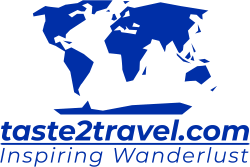Liberia Travel Guide
This is a Liberia Travel Guide from taste2travel.com
Date Visited: March 2025
Introduction
I first attempted to visit Liberia in 1992 while on an 18-month, solo, backpacking trip from the top to the bottom of Africa.

Flashback 1992: Me, as a young, crazy kid, visiting the Akodessawa Fetish Market in Lome, Togo.
In those days I was a 24-years young, crazy, kid looking for adventure.
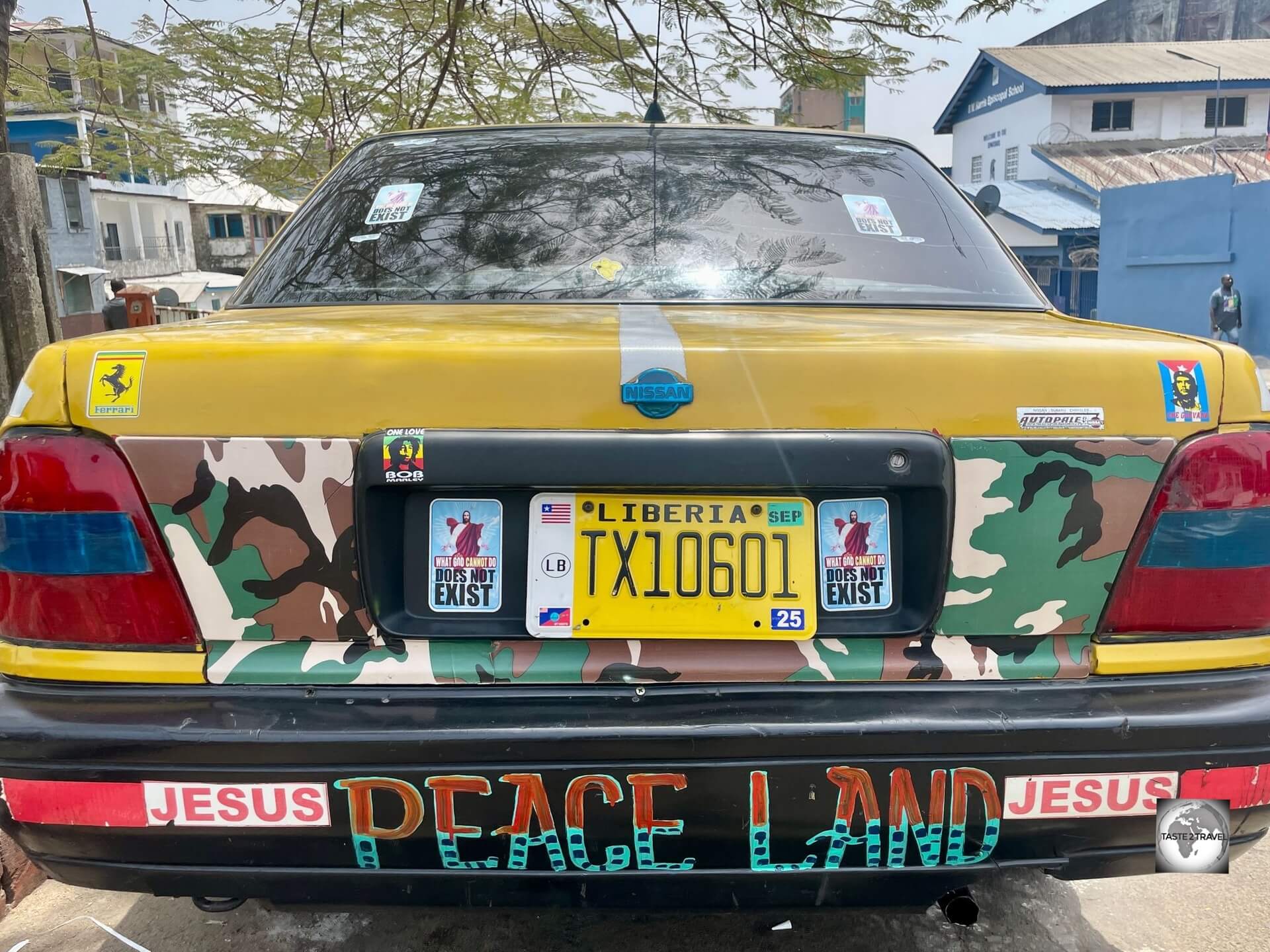
A taxi in downtown Monrovia.
On that trip, which was before internet, guidebooks, ATM’s, mobile phones, email etc, I spent 6 months meandering through all the countries of West Africa, using just a Michelin roadmap – North and West Africa (#741).
After 6 months, I had managed to slowly explore (as is my style) all the countries of West Africa, except for Liberia which was completely closed due to the First Liberian Civil War (1989–1996) which was raging at the time.

A corner store in West Point slum.
The war was being fought by Charles Taylor who led a Libyan-backed rebel group, the National Patriotic Front of Liberia, to overthrow the government of Samuel Doe.
Charles Taylor won the war and, following the execution of Samuel Doe, became Liberia’s 22nd President.
During his term in office, Taylor was accused of war crimes and crimes against humanity and, in May of 2012, was sentenced by the ICC (International Criminal Court) to 50 years in prison.
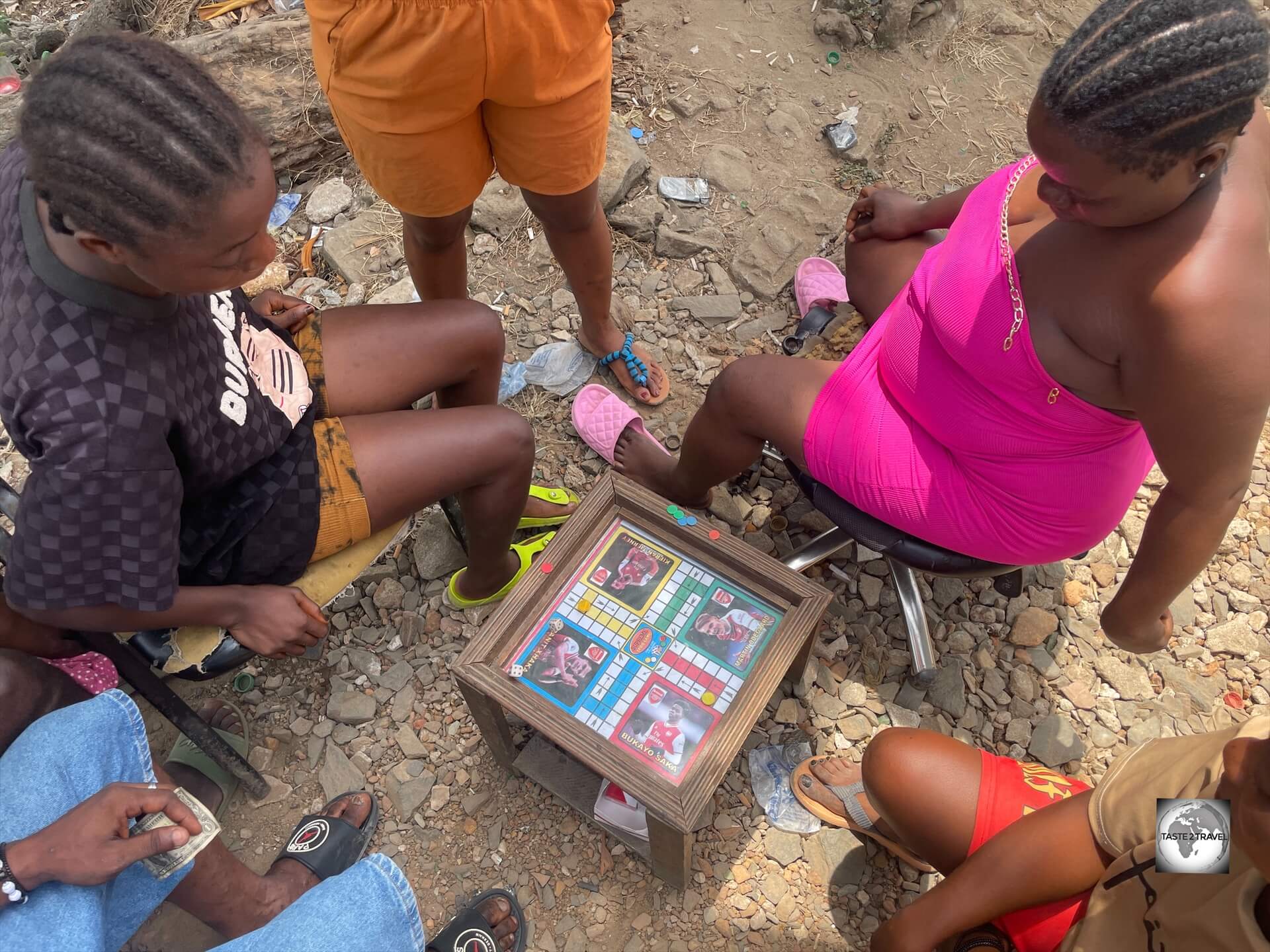
Locals in Monrovia, gambling on the popular boardgame – “African Delights’ Ludu Board Game” which features African cultural figures.
Back to 1992! Despite the war, I had a Liberian visa in my passport and I was keen to visit.
I had just left Sierra Leone, where a young Captain Valentine Strasser had recently become the world’s youngest head of state, seizing power in a coup, at the age of 25.
Freetown was a crazy place in the post-coup days so I thought I should also try to enter Liberia.
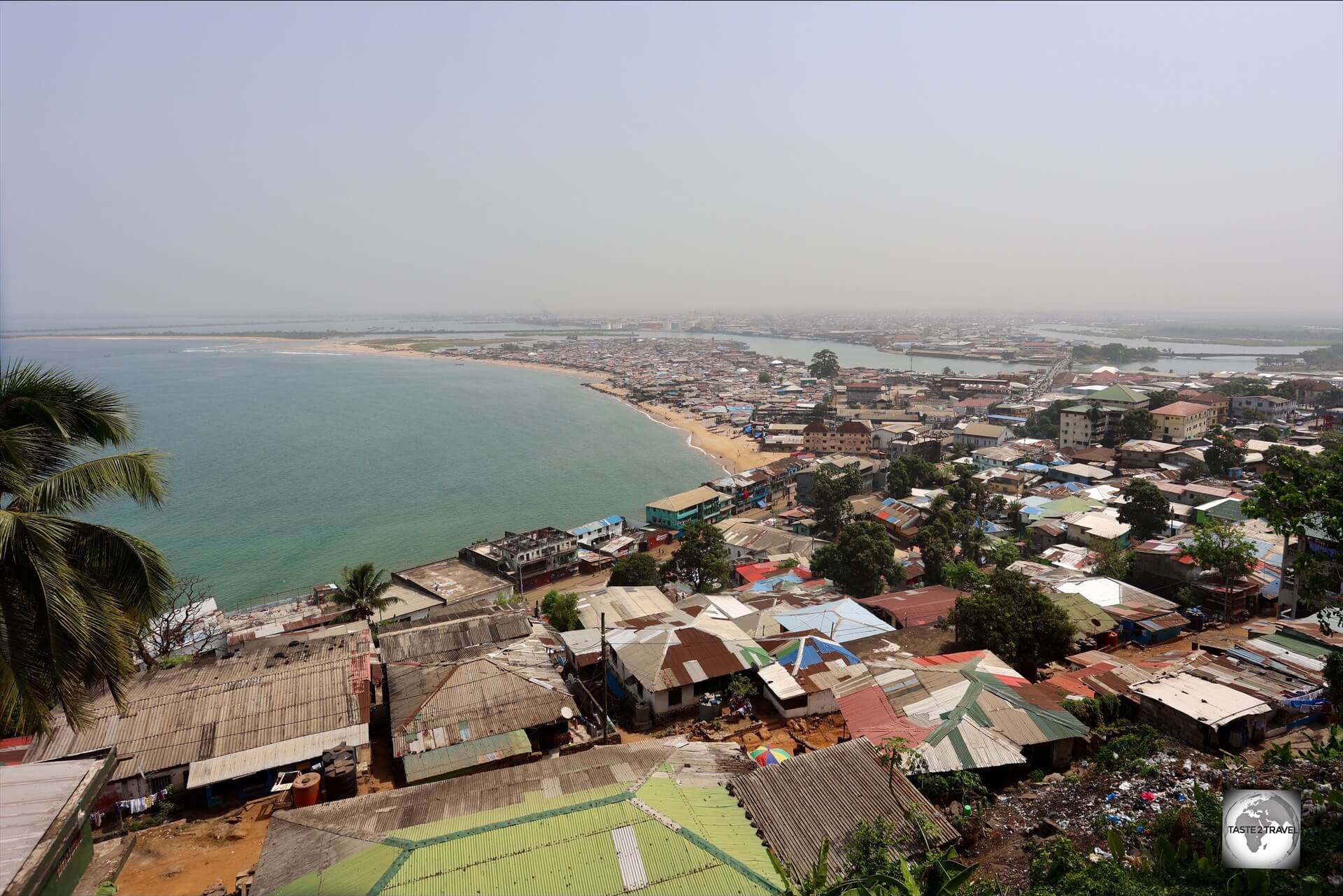
A view of Monrovia, and, in the distance, the crowded West Point, the largest slum in Liberia which is home to 90,000 people, as seen from the roof of the abandoned Ducor Hotel.
In an attempt to enter war-torn Liberia, I travelled through the remote jungle, on the Guinean side of the Guinea/ Liberia border, where I met Liberian refugees who had fled across the border and were being housed in UNHCR refugee camps.
Everyone I spoke to said it was far too dangerous to enter Liberia and that I would certainly die!

Artwork, at the Liberian National Museum in Monrovia.
I decided not to enter, and to keep heading east, where I eventually entered Côte d’Ivoire (Ivory Coast).
Fast-forward to March 2025, and, after a delay of 33 years, I found myself finally boarding a flight in Brussels and heading to Monrovia.
The wait was over!
I thoroughly enjoyed my time in Liberia.
After many years of Civil War, a deadly Ebola virus outbreak and more, the Liberians are full of optimism for the future.
Liberia is a worthwhile travel destination but, at this stage, is best suited to more intrepid travellers.
Location

A souvenir wood carving shows the 15 counties of Liberia.
Liberia is located in West Africa, positioned along the Atlantic Ocean’s coastline.
To the west, Liberia shares a border with Sierra Leone, while to the north, it is bordered by Guinea.
To the east, Liberia shares its boundary with Côte d’Ivoire (Ivory Coast).
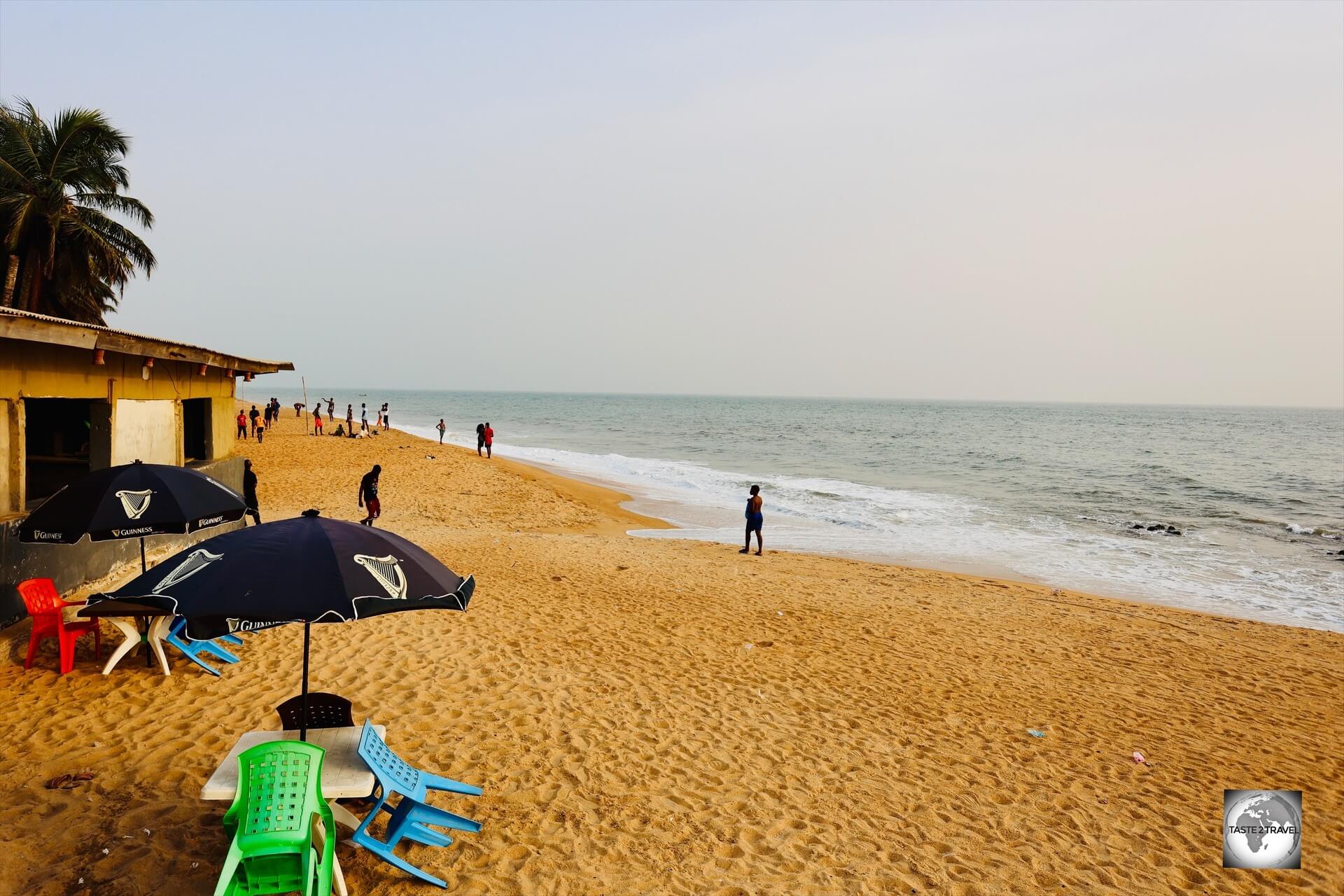
Liberia boasts 560 kilometres (350 miles) of Atlantic coastline with many fine, golden-sand beaches.
The country’s coastline stretches for about 560 kilometres (350 miles), offering picturesque beaches and natural harbours along the Atlantic.
Liberia is divided into 15 counties – Bomi, Bong, Gbarpolu, Grand Bassa, Grand Cape Mount, Grand Gedeh, Lofa, Margibi, Montserrado, Nimba, Ngn, River Cess, River Gee, Sinoe, and Maryland.
Geographically, Liberia’s landscape is diverse, featuring coastal plains, mountainous regions, tropical rainforests, and savannahs.
The Guinea Highlands form the country’s northeastern border, while the Liberian Coastal Plain runs along the coastline. The country is also crisscrossed by numerous rivers, including the Lofa River, Cavalla River, and St. Paul River, which are crucial to its ecology and economy.
The mix of coastal and inland terrain gives Liberia a rich variety of ecosystems, from dense forests and wildlife reserves to open savannah areas, making it a unique and scenic destination in West Africa.
People

The Liberians are generally friendly, warm and welcoming.
The people of Liberia are known for their warmth, resilience, and rich cultural heritage, reflecting the diverse history and traditions of the country.
As with other African countries, visitors need to be wary of their security, since most Liberians live in poverty and tourists are seen as easy targets. However, I never experienced any issues and found the people to be welcoming and friendly.

A proud fisherman in West Point, the largest slum in Liberia.
The country has always been home to a diverse range of ethnic groups which include the Kru, Bassa, Gio, Mano, Lorma, and Mende peoples, among others. These were the original occupants of the land.

I was normally greeted by warm smiles in Liberia, including from this girl in the West Point neighbourhood of Monrovia.
Introduced somewhat later into the mix, the Americo-Liberians is one of Liberia’s most distinctive cultural groups. These are descendants of freed African-Americans and formerly enslaved people from the U.S. who migrated to Liberia in the 19th century.
This group played a key role in the founding of Liberia and has influenced the country’s history, politics, and cultural identity.
Americo-Liberians traditionally follow Christian faith and have contributed to Liberia’s political and social development.

A sculpture at the Liberian National Museum which depicts Liberians helping each other to rise up.
In addition to English, various indigenous languages are spoken, with the most common being Kru, Bassa, Gio, and Lorma.
In terms of religion, Liberia is predominantly a Christian country, with many people adhering to various Christian denominations, especially Protestantism.
However, there is also a significant Muslim minority, particularly among ethnic groups along the northern border, and traditional African religions are still practiced by some communities.
History
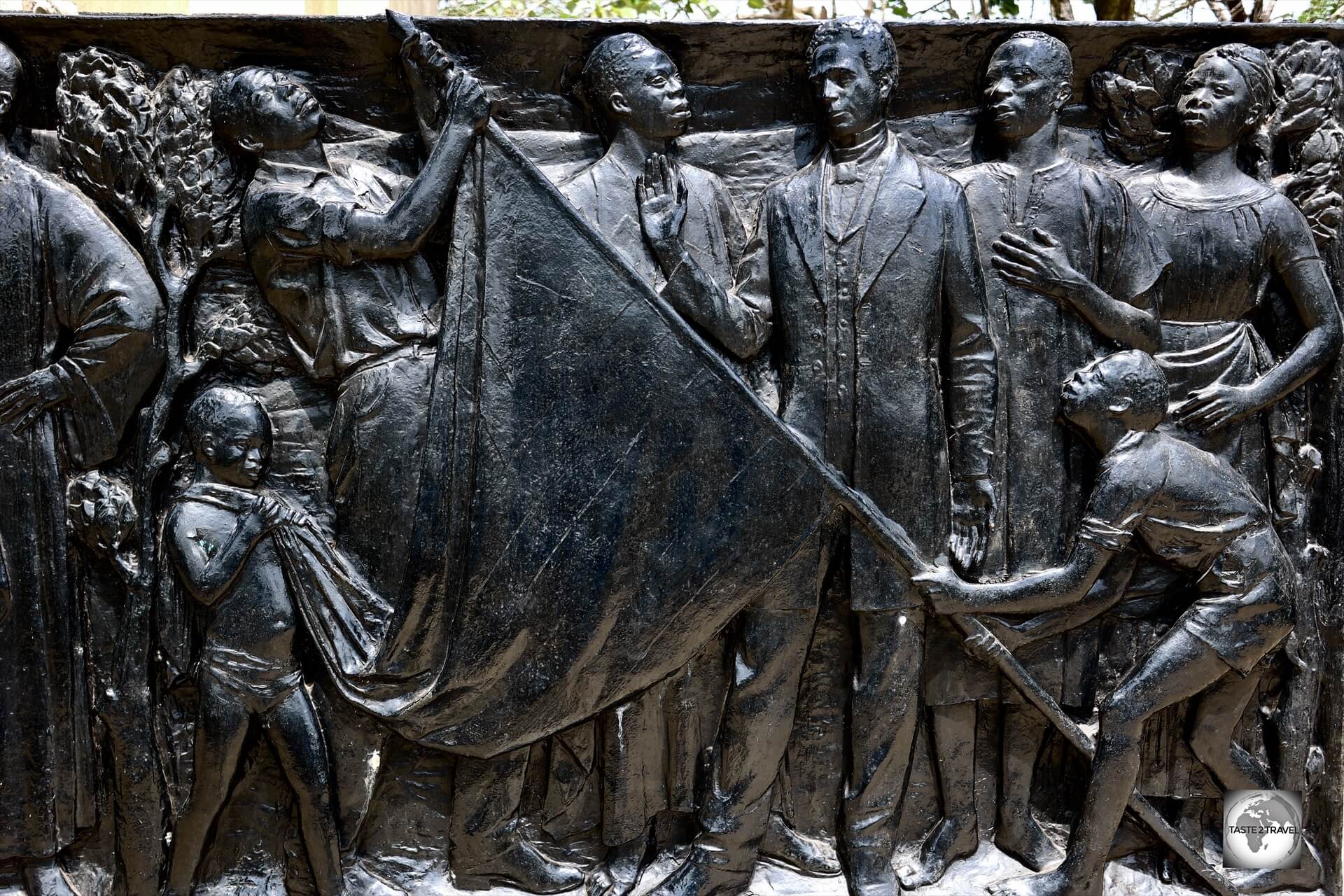
Bronze relief plates at the Joseph J. Roberts Monument depict the life of Liberia’s first president.
Liberia has a unique and complex history.
It is one of the few African countries not colonised by a European power (along with Ethiopia), though its creation was closely linked to the transatlantic slave trade and the abolitionist movement.
Pre-Colonial and Indigenous Peoples
Before European contact, the area that is now Liberia was inhabited by several indigenous groups, including the Kpelle, Bassa, Grebo, and Mende.
These groups had their own rich cultures, systems of governance, and trade networks.
The land was known for its fertile soil and natural resources, which attracted external interest.
European Exploration and the Slave Trade (15th–18th Centuries)
European interest in Liberia began in the 15th century, with Portuguese explorers being among the first to arrive.
The region became an important part of the transatlantic slave trade.
Many enslaved Africans were transported to the Americas, but some were also brought back to Africa by European traders, including the British and Americans.
By the 18th century, the area was becoming a hub for the establishment of colonies for freed slaves, particularly by the United States.
Founding of Liberia (1820s)
The origins of modern Liberia can be traced to the American Colonisation Society (ACS), which was founded in 1816.
The aim of the society was to encourage and support the repatriation of freeborn people of colour and emancipated slaves to the continent of Africa.
However, the African-American community and the abolitionist movement overwhelmingly opposed the project.
Controversially, the ACS was founded to address the prevailing view that free people of colour could not integrate into U.S. society; their population had grown steadily following the American Revolutionary War, from 60,000 in 1790 to 300,000 by 1830.
Slave owners also feared that these free Black people might help their slaves to escape or rebel.
In addition, many White Americans believed that African Americans were inherently inferior and should be relocated to Africa.
In most cases, African American families had lived in the United States for generations, and their prevailing sentiment was that they were no more African than white Americans were British.
Contrary to claims that their emigration was voluntary, many African Americans, both free and enslaved, were pressured into emigrating.
In 1821, the ACS began sending free African Americans and formerly enslaved people to what is now Liberia, establishing the colony of Liberia in 1822.
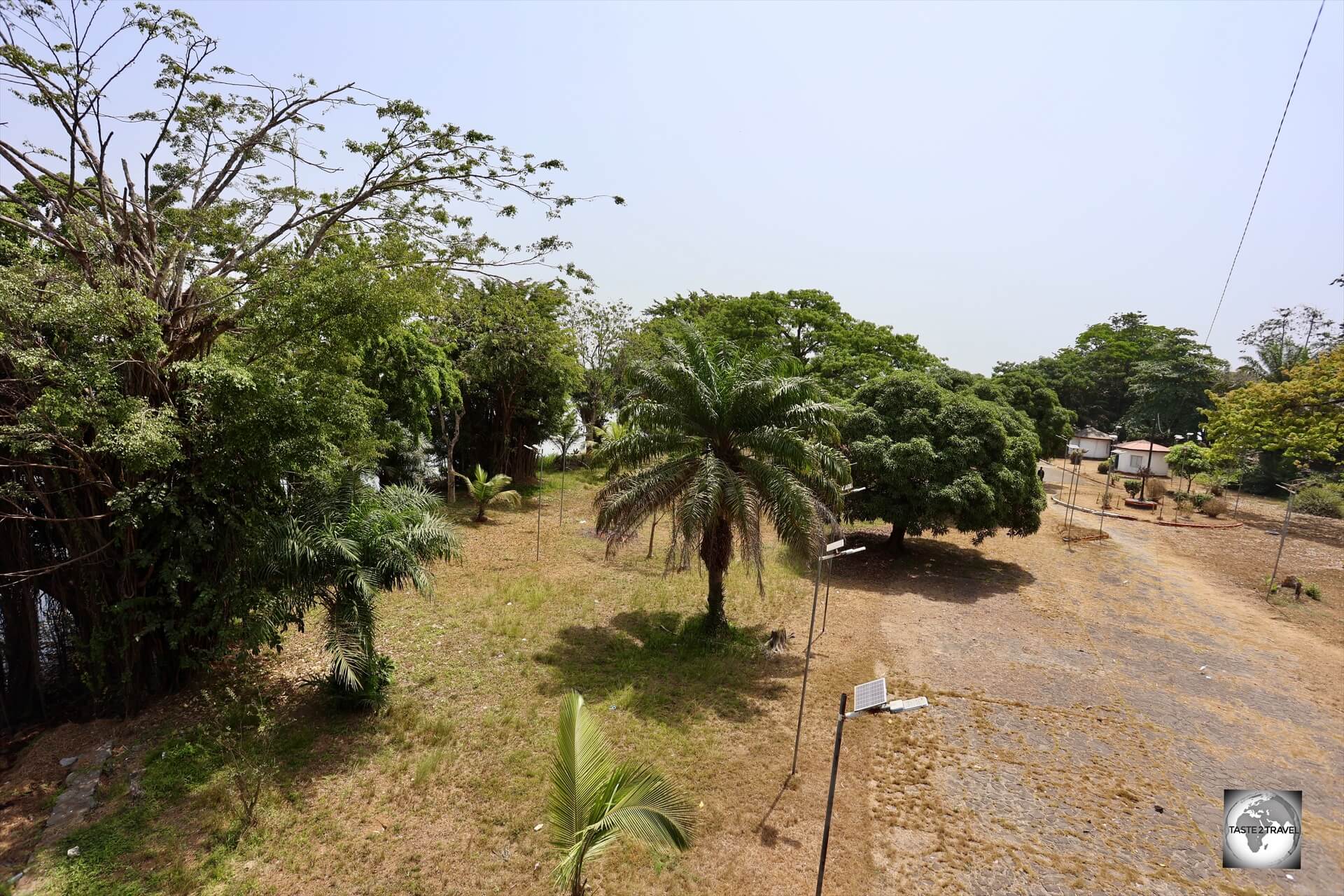
Surrounded by the Mesurado River, in downtown Monrovia, Providence Island was the site of the first successful settlement of American freed slaves.
The settlers initially settled on tiny Providence Island which is located in downtown Monrovia.
The settlement was named Liberia, derived from the Latin word for “freedom,” in recognition of the freedom the settlers sought.
These settlers, who called themselves Americo-Liberians, established a society that closely resembled the United States, including its form of government and legal system.
A highly unsuccessful project, between 1821 and 1847, only a few thousand African Americans, out of millions, emigrated to what would become Liberia, while the increase in Black population in the U.S. during those same years was about 500,000.
Liberia’s Independence (1847)
Liberia declared its independence on July 26, 1847, becoming the first republic in Africa.
The Americo-Liberians established a government modeled on the U.S. Constitution, with a president, legislature, and judicial system.
Joseph Jenkins Roberts, an Americo-Liberian, became Liberia’s first president.
The Americo-Liberian Era (1847–1980)
For much of Liberia’s early history, power was controlled by the Americo-Liberian elite, who often treated indigenous groups as second-class citizens.
The indigenous people faced discrimination and exclusion from political power, which led to tensions and resentment.
During this period, Liberia maintained strong ties with the United States, which supported its development and provided military protection.
Liberia also served as a symbol of the ideals of freedom and independence in the context of African history.
The 1980 Coup

Artwork, at the Liberian National Museum in Monrovia, illustrates the struggle for unity in Liberia.
In 1980, dissatisfaction among the indigenous population, coupled with economic inequalities, led to a military coup.
Samuel K. Doe, an ethnic Krahn, led a group of soldiers in overthrowing the Americo-Liberian government, marking the end of nearly 133 years of rule by the Americo-Liberians.
Doe established a new military government, but his rule was marked by corruption, repression, and human rights abuses, particularly against his political opponents.
Liberian Civil War (1989–1997)
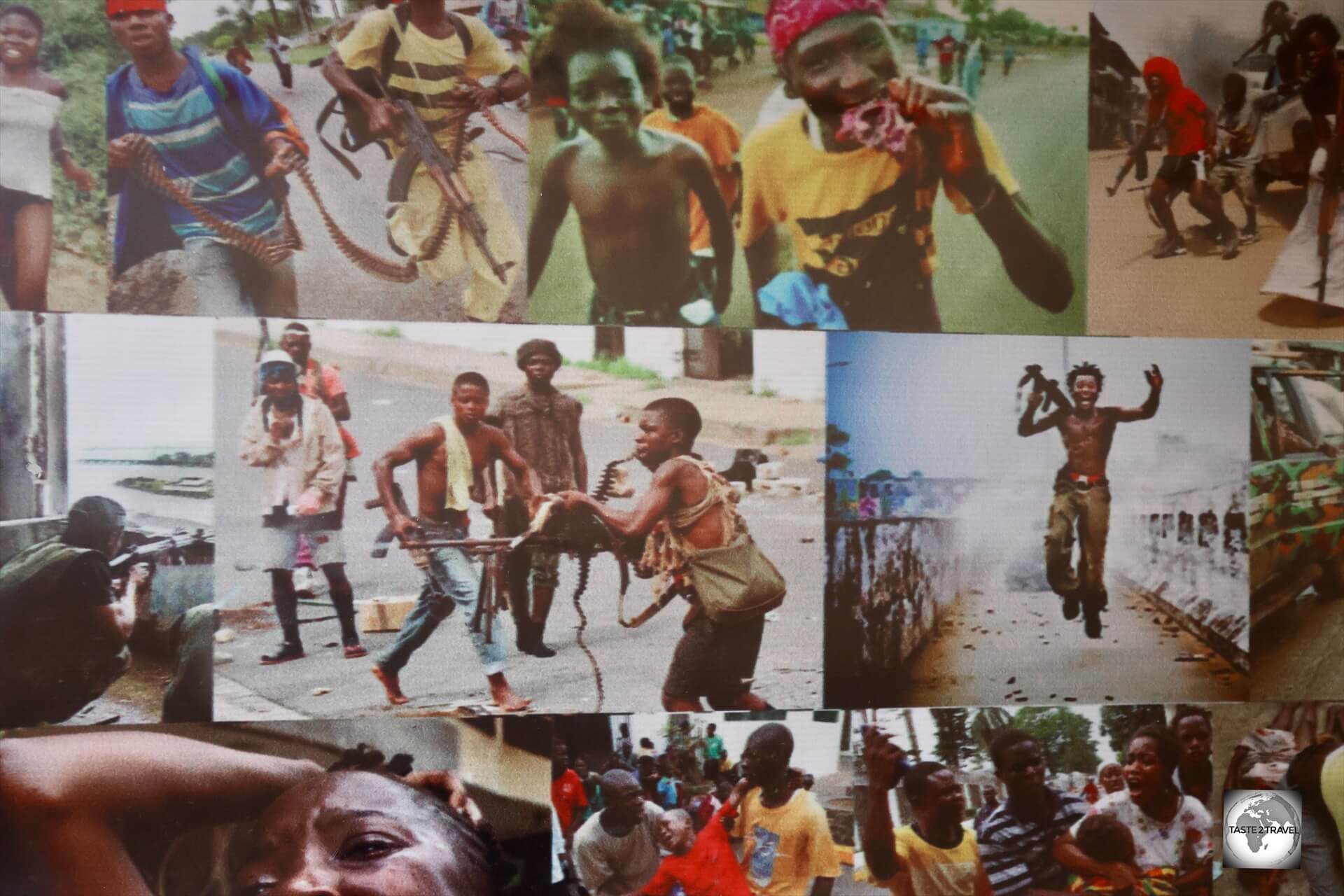
Photos from the Liberian Civil War, on display at the Liberian National Museum.
In 1989, Liberia plunged into a brutal civil war, sparked by Charles Taylor’s insurgency against President Doe.
The conflict was complicated by ethnic tensions, political factions, and the involvement of neighboring countries.
The war resulted in widespread devastation, with over 200,000 people killed and millions displaced.
The war saw several factions, including Taylor’s National Patriotic Front of Liberia (NPFL), as well as other warlords, vying for power.
The international community, including the United Nations and the Economic Community of West African States (ECOWAS), intervened with peacekeeping forces, but it wasn’t until 1997 that Taylor emerged victorious in the country’s first post-war elections, becoming president.
Second Civil War and the Fall of Charles Taylor (1999–2003)
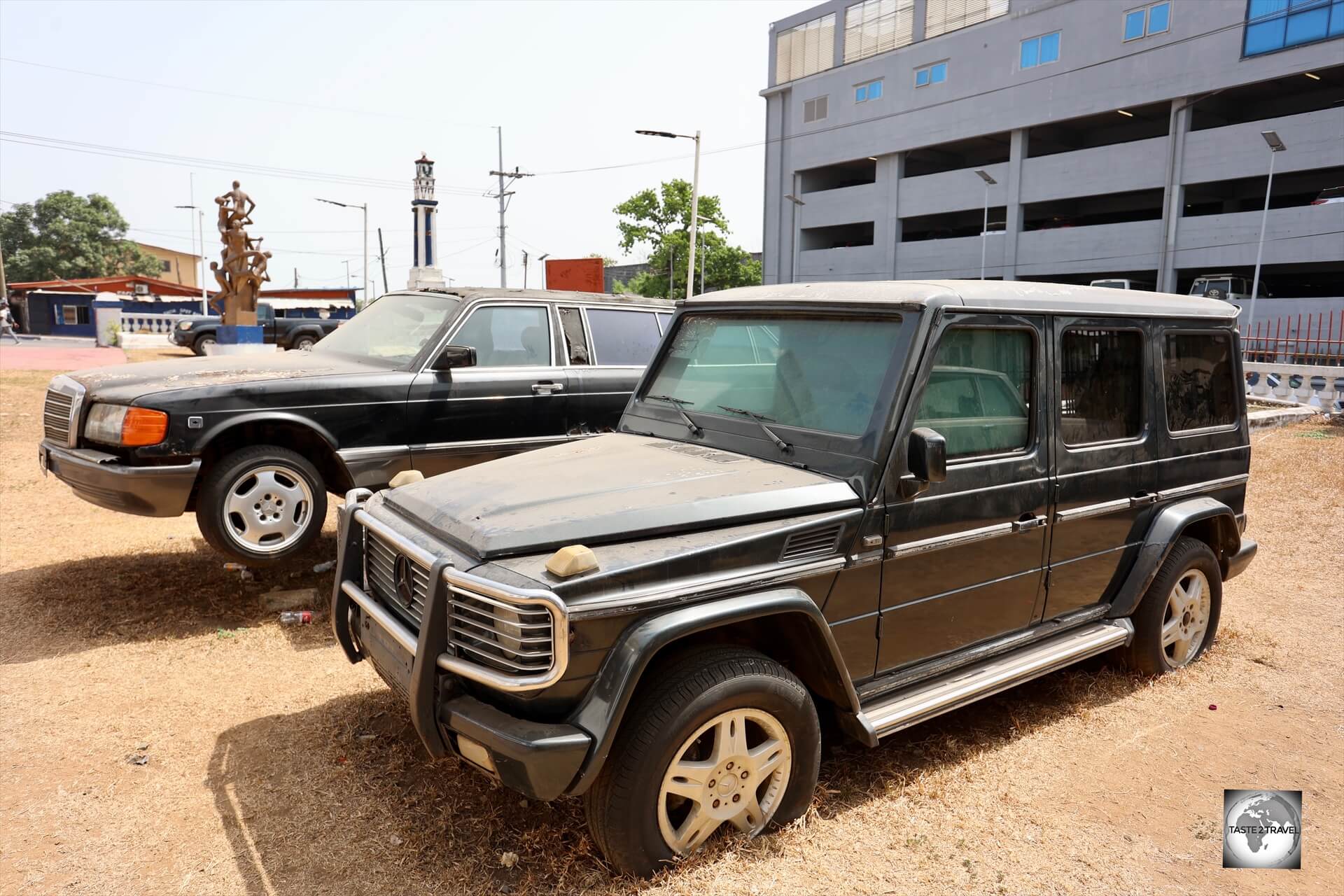
A bulletproof Mercedes, which was a gift from Colonel Gaddafi to Charles Taylor, at the Liberian National Museum.
Although Taylor was elected president in 1997, his rule was marred by corruption, human rights abuses, and continued conflicts with rebel factions.
This led to a second civil war in 1999, which was even more brutal than the first. The war involved numerous rebel groups and saw widespread atrocities, including massacres and the use of child soldiers.
In 2003, as Taylor’s regime collapsed, international pressure and a peace agreement led to his departure.
Taylor was later tried for war crimes by the Special Court for Sierra Leone.
On 20 June 2006, the Special Court for Sierra Leone transferred Charles Taylor to the detention centre of the International Criminal Court (ICC) in The Hague for the purpose of using the facilities of the ICC during his trial.
In May 2012, Charles Taylor was sentenced to 50 years in prison. He was 64 years of age at the time of sentencing.
Post-War Reconstruction
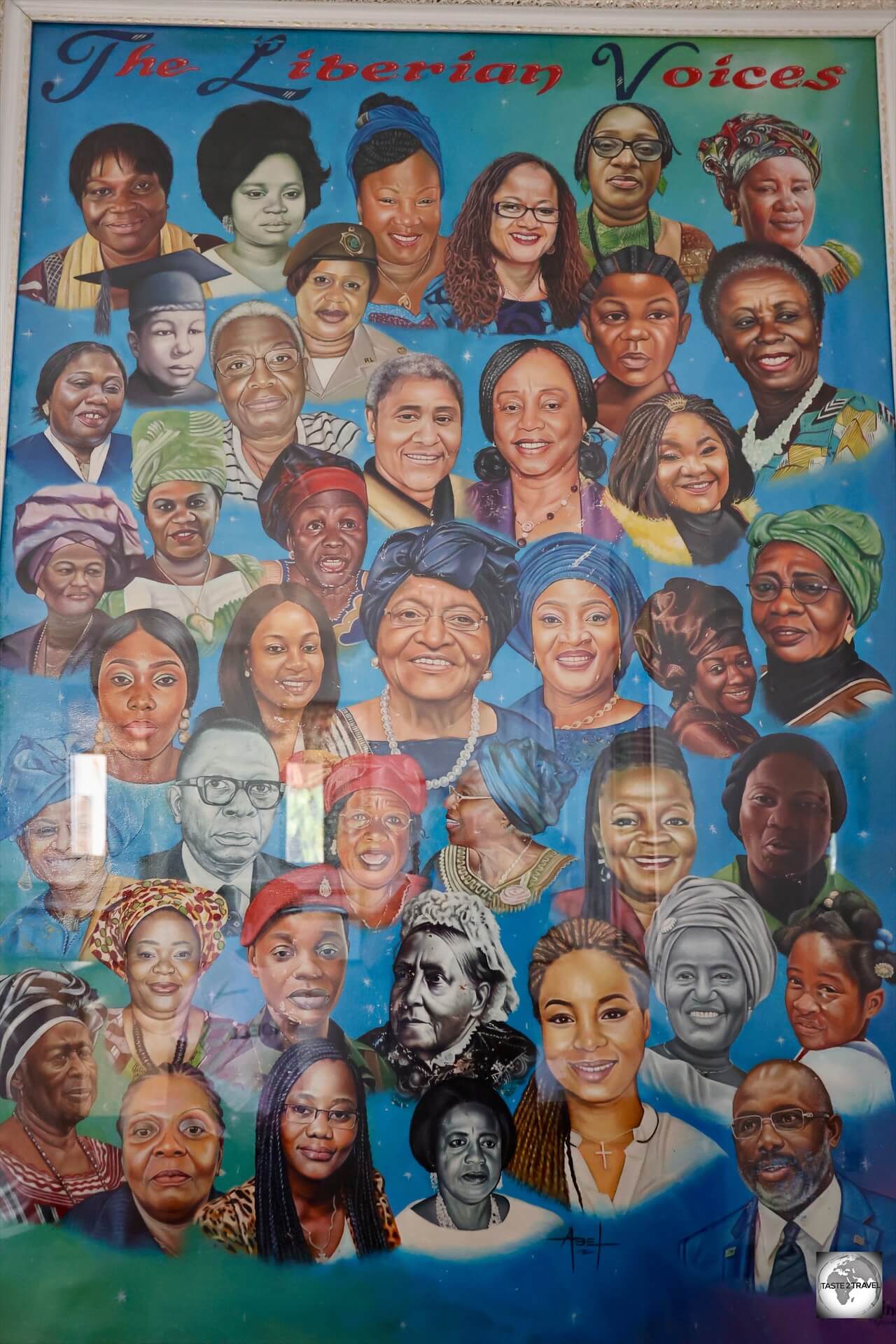
Former president, Ellen Johnson Sirleaf, looms large at the centre of this painting at the Liberian National Museum in Monrovia.
After the war, Liberia faced the immense task of rebuilding its infrastructure, economy, and social fabric.
In 2005, Liberia elected Ellen Johnson Sirleaf as president, making her the first female head of state in Africa.

The desk, which was used by President Ellen Johnson Sirleaf, on display at the Liberian National Museum.
Her presidency focused on rebuilding the country, strengthening democratic institutions, and securing international aid.
Under her leadership, Liberia experienced a period of relative stability and economic growth, though challenges such as poverty, unemployment, and corruption remained.
Ebola Virus (2014)

Photos, from the 2014 Ebola virus outbreak, on display at the Liberian National Museum.
In 2014, Liberia experienced a devastating Ebola outbreak that originated in Guinea and quickly spread, leading to a surge in cases and deaths, particularly in the capital Monrovia, and ultimately resulting in a global health emergency.
The outbreak commenced in March 2014 with the entire West Point slum (home to 90,000 people) in Monrovia being locked down.
Liberia was finally declared free of Ebola virus transmission by the WHO on May 9, 2015.
In the end, the country reported 10,672 cases of Ebola and 4,808 deaths.
Recent Developments
In 2018, George Weah, a former soccer star, was elected president in a democratic transition.
While his administration focused on economic reforms and tackling corruption, Liberia continued to face significant challenges, including high unemployment, infrastructure deficits, and poverty.
On January 22, 2024, Joseph Boakai was sworn in as the twenty-sixth and current president of Liberia.
Taking up office at 79, he was the oldest president of the country.
Flag
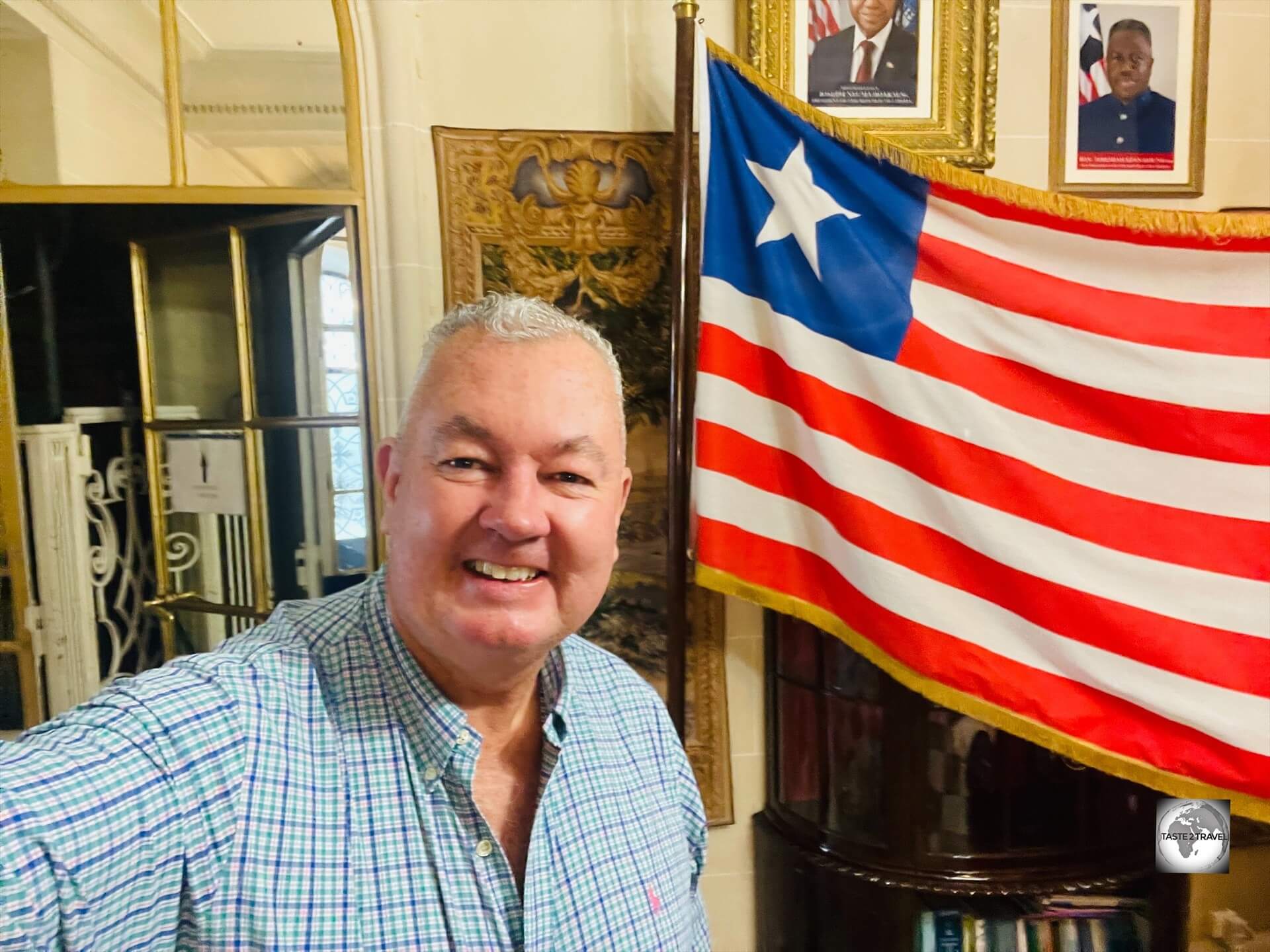
Posing, with the flag of Liberia, at the Liberian embassy in Paris.
Very much part of the stars and stripes flag family, the flag of Liberia bears a close resemblance to the flag of the United States, representing Liberia’s founding by former black slaves from the US.
The flag was adopted on July 26, 1847, the same day Liberia declared its independence.
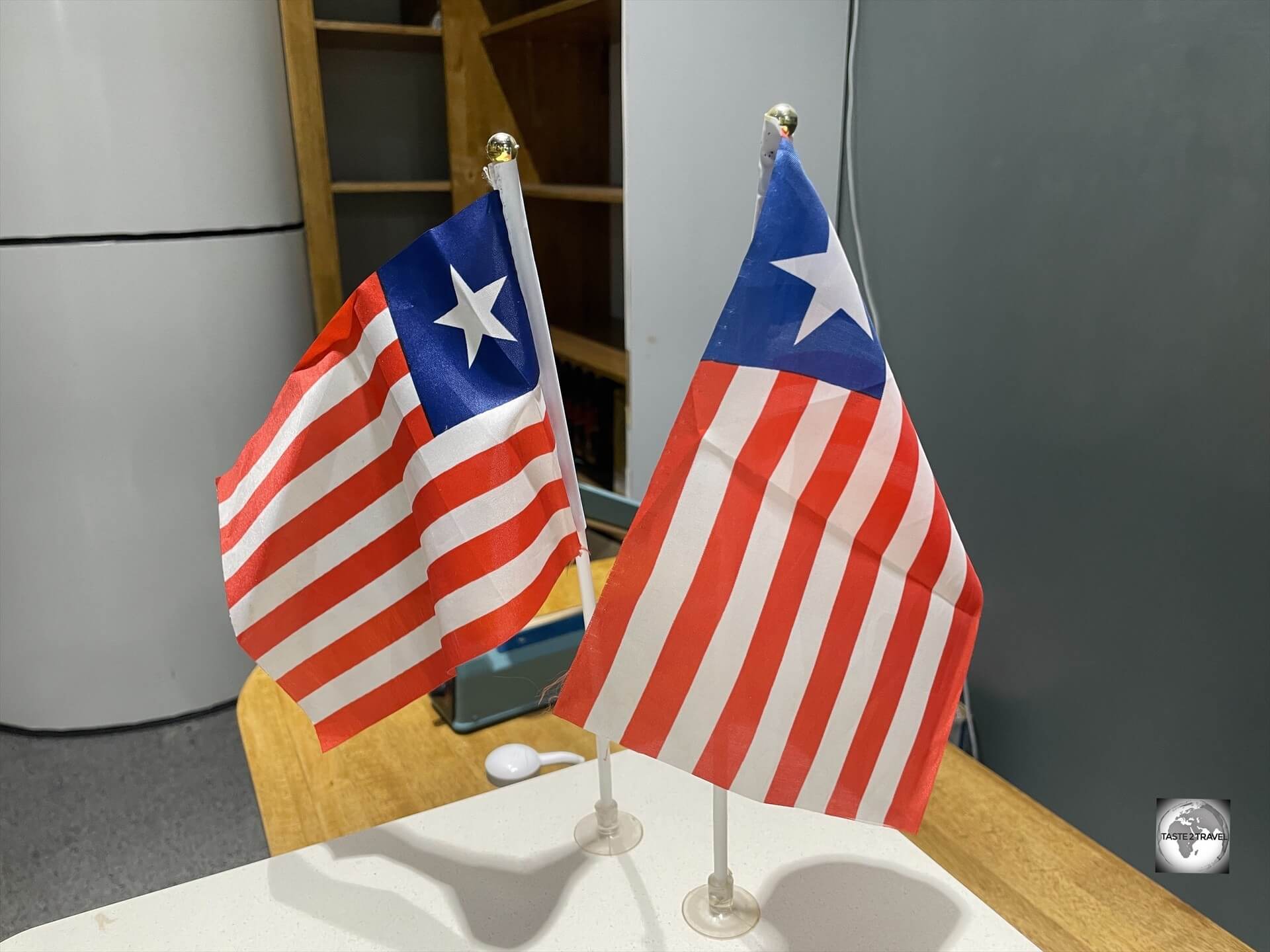
The design of the flag of Liberia is heavily influenced by the flag of the United States.
The flag consists of 11 horizontal red and white stripes, representing the 11 signatories of the Liberian Declaration of Independence.
The stripes symbolise the country’s fight for independence and the unity of its people.
The white Star in the top left-corner represents Liberia as the “Land of Freedom” and symbolises the freedom and liberty that the country gained after declaring its independence.
Currency
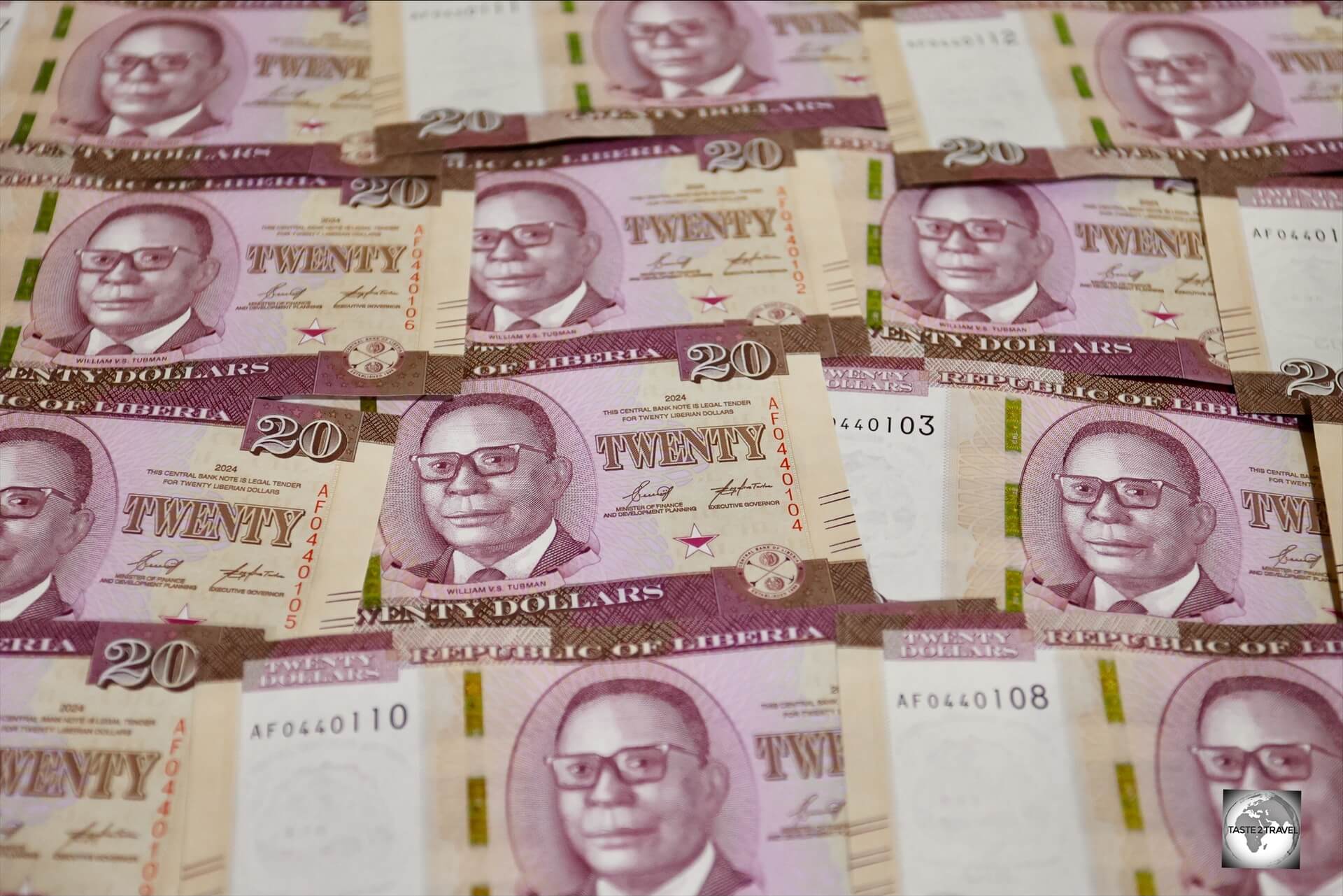
The currency of Liberia is the Liberian dollar which trades under the international currency code of LRD.
Liberian Dollar
Issued by the Central Bank of Liberia, the Liberian Dollar, which trades under the international currency code of LRD, is the official currency of Liberia.

A rather sad currency display at the Liberian National Museum.
The first Liberian dollar was issued in 1847 and was pegged to the US dollar at par and circulated alongside the US dollar until 1907, when Liberia adopted the British West African pound, which was pegged to sterling.
The Liberian dollar was re-instated in 1943.

The LRD $20 banknote features a portrait of Liberia’s 18th President, William V.S. Tubman.
A bonus for foreign visitors is that the United States Dollar (USD$) is also legal tender in Liberia and is used widely alongside the Liberian Dollar currency.
This allows visitors to arrive with a mix of USD banknotes and not have to worry about withdrawing money from an airport ATM or exchanging money on arrival. You simply pay for everything with your USD.
ATMs in Monrovia (when working) dispense either USD$ or LRD$, although USD$ notes are always old and in very shabby condition.
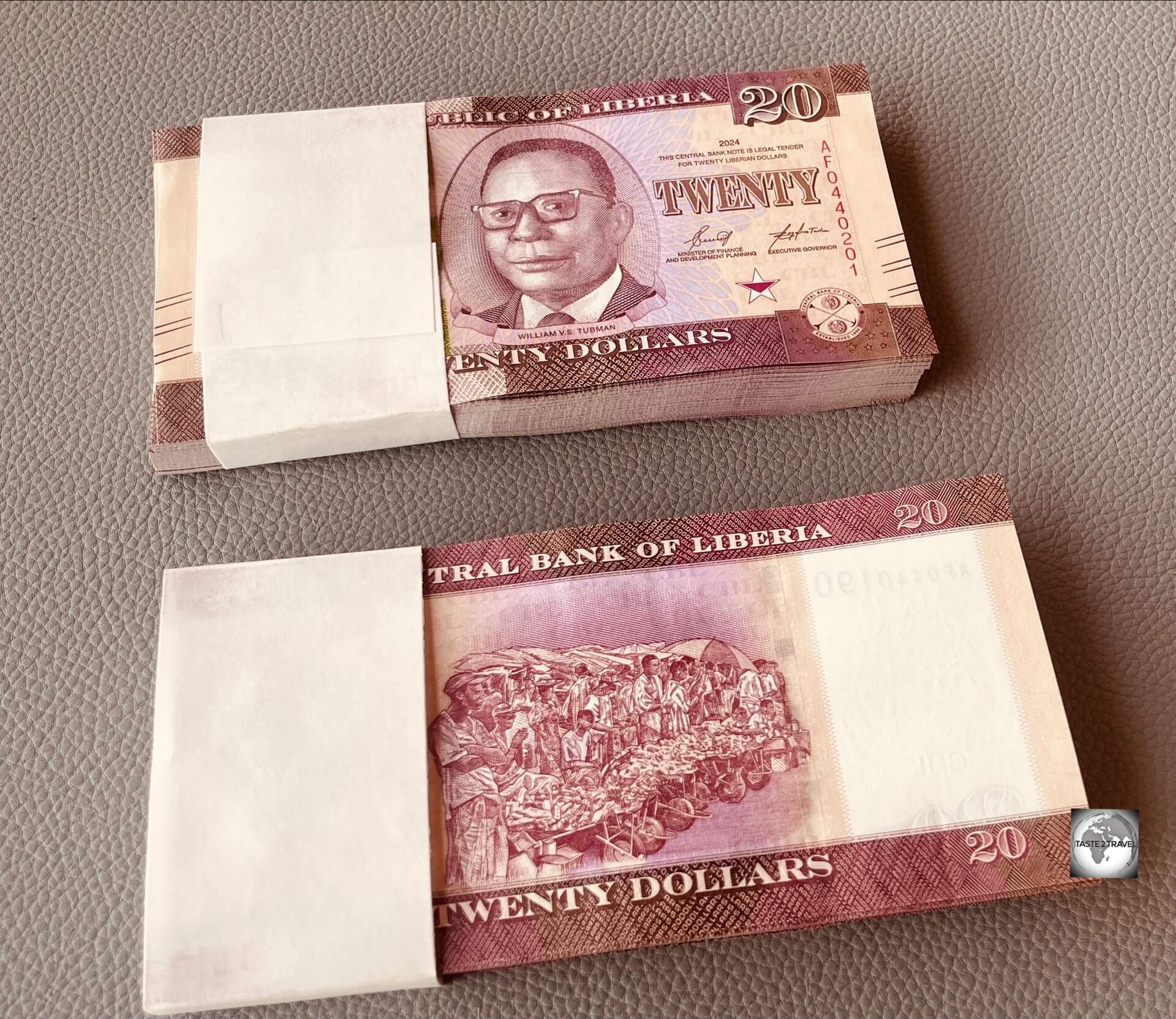
I purchased these two wads of uncirculated LRD $20 banknotes from a currency trader in Monrovia.
The Liberian currency comprises banknotes and coins with LRD banknotes issued in the denomination of $5.00, $10.00, $20.00, $50.00 and $100.00 while coins are issued in the denomination of $0.05, $0.10, $0.25, $0.50 and $1.00.
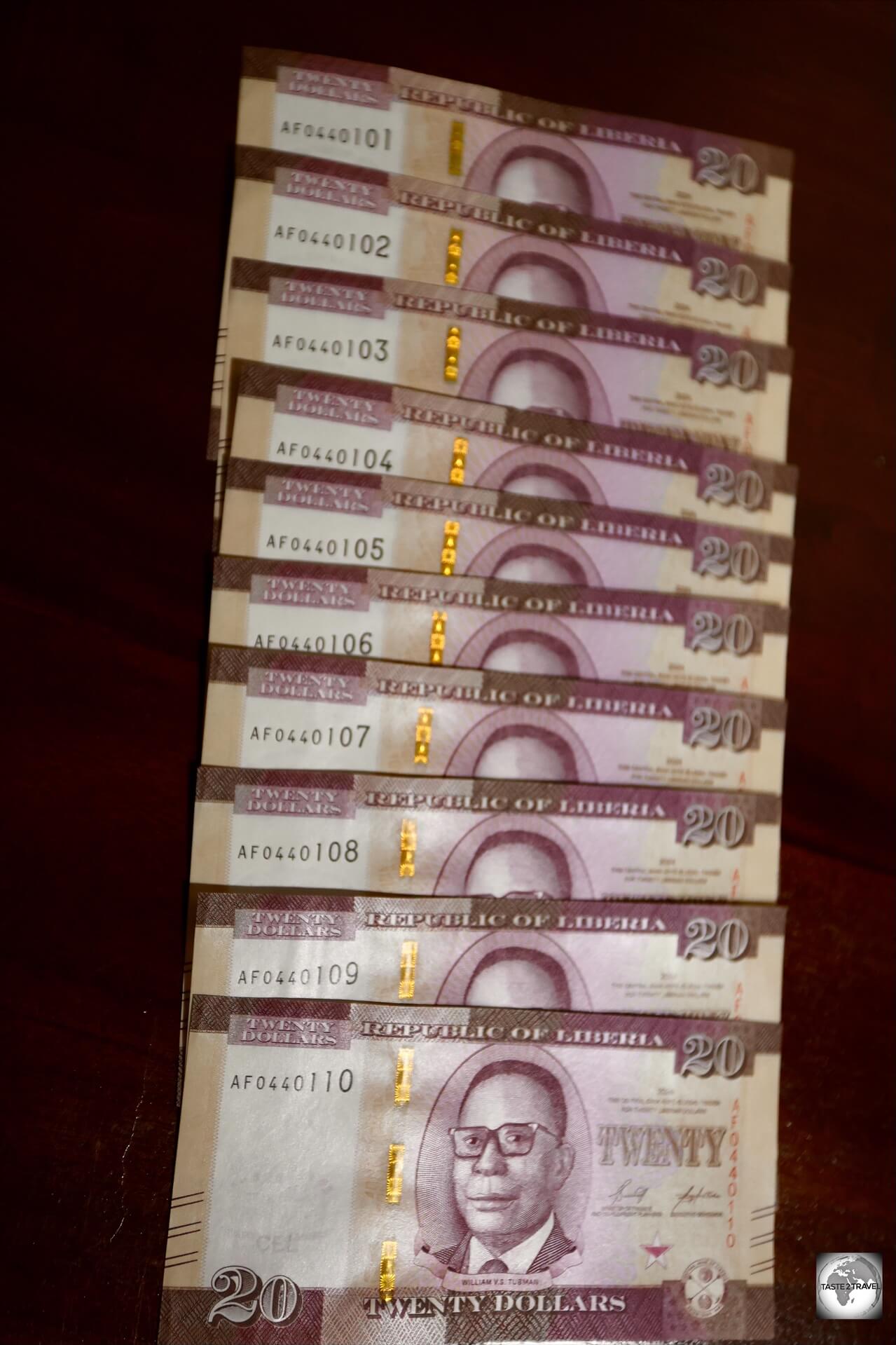
A small selection of my uncirculated Liberian dollar banknotes, in numerical order.
The obverse (face) side of all banknotes feature former Liberian presidents, with the LRD $20 banknote featuring President Tubman, the 19th president of Liberia and the country’s longest-serving president.
I purchased two wads of uncirculated LRD $20 banknotes (worth USD$20 in total) from a currency trader on Ashmun Street, the main street of Monrovia.
If you wish to purchase uncirculated banknotes, you can do so from the money changers on Ashmun Street.
US Dollar

Very shabby USD banknotes which were issued by an ATM in Monrovia.
While the US dollar circulates widely alongside the Liberian dollar, the condition of USD banknotes, like the Liberian banknotes, is always bad.
The very sad looking notes pictured above were issued to me by an ATM in Monrovia.
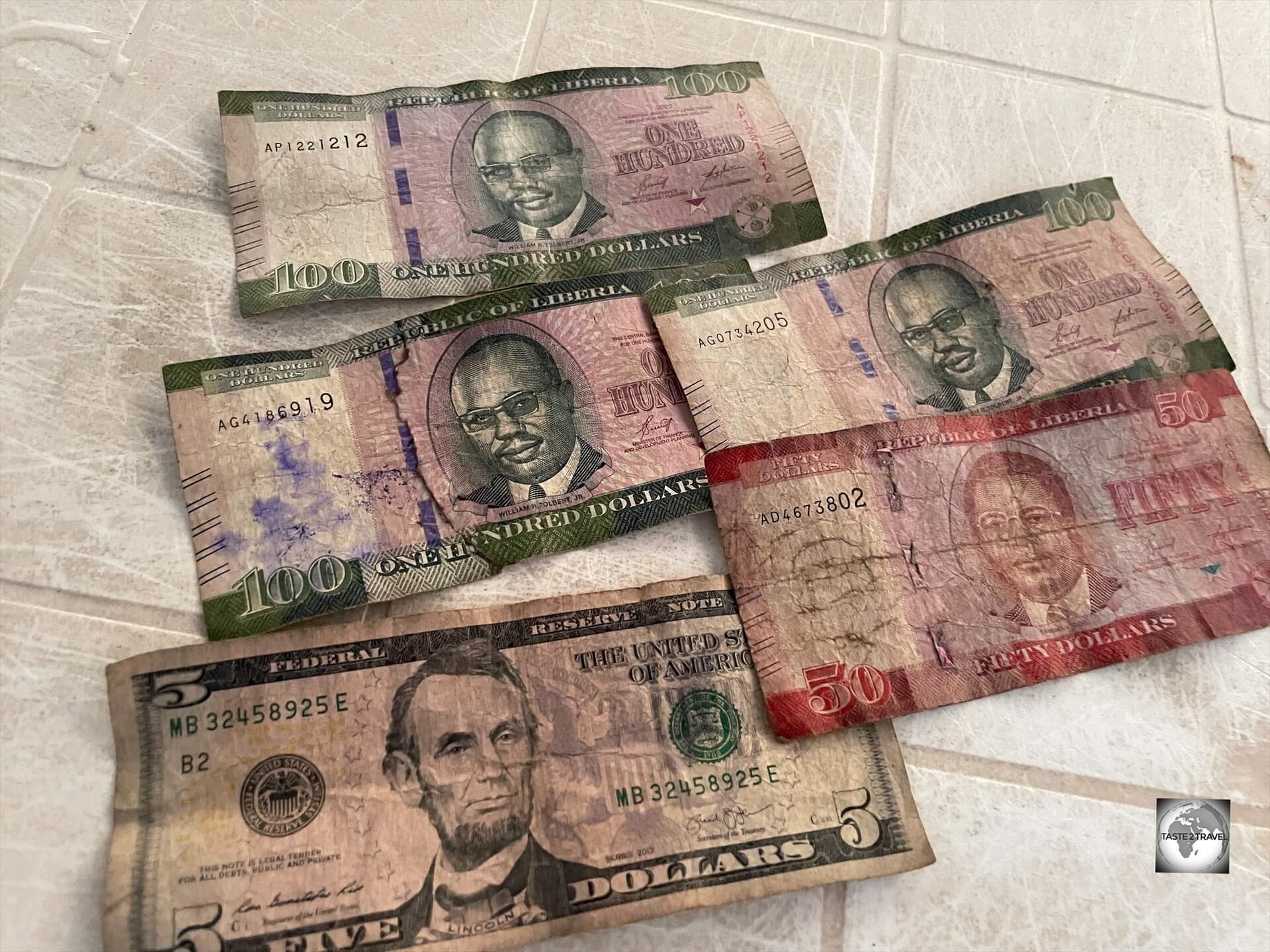
Change in Liberia, such as these notes which I received as change in a cafe, is often given as a mixture of US and Liberian dollars.
Dirty, dusty, smelly, shabby, creased, torn, completely soiled – most banknotes in circulation in Liberia (both USD and LRD) are in terrible condition.
For this reason, it’s important to spend any poor-quality USD banknotes before leaving Liberia as money changers in other countries would definitely refuse to accept such notes.
Currency Exchange
Like most other African countries, cash is king in Liberia with credit cards rarely accepted.
If you are staying at The Cape Hotel, or other upmarket hotels, you can settle your bill using a credit card (Mastercard and Visa).
When carrying foreign currency into Liberia, it’s important that you only bring USD for exchange since money changers only accept USD – they will not accept Euros!
During my visit, in March 2025, the exchange rate was:
- USD$100 = LRD$ 19,962
Click to check the current USD$/ LRD$ exchange rate.
Costs
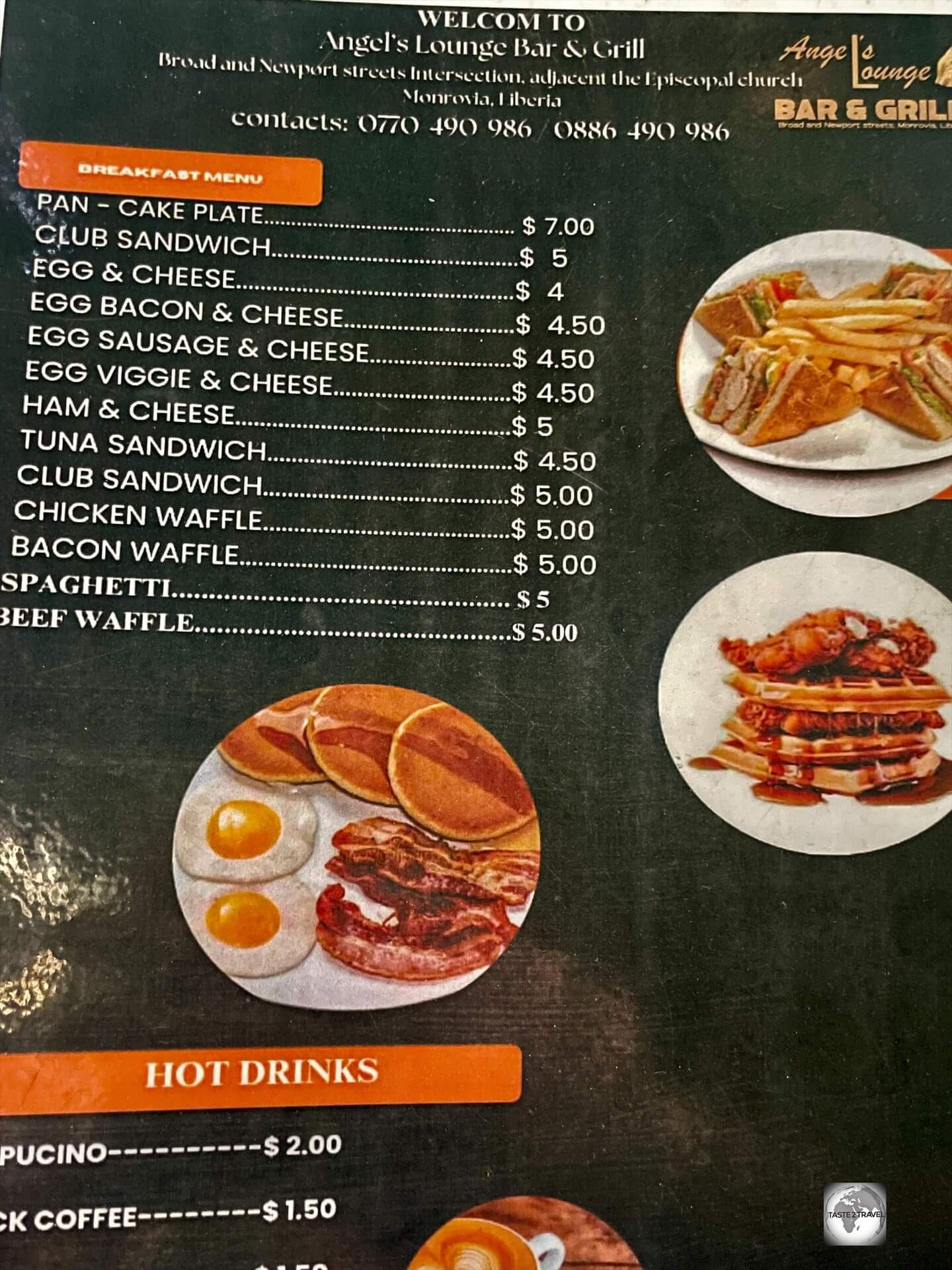
Menu prices at Angel’s Lounge Bar and Grill in Monrovia.
For the most part, travel costs in Liberia are totally reasonable.
The biggest expenses are accommodation and flights to this remote country, which has just a few airlines flying monopoly routes and charging monopoly prices.
Sample costs:
- Breakfast at Angels Lounge: US$4-5.00
- Meal, inexpensive Restaurant: US$7.50
- Meal, expensive Restaurant: US$15.00
- Cappuccino at Angels Lounge: US$2.00
- Club beer: US$1.50
- Coke/Pepsi (0.33 litre bottle): US$2.00
- Bottle of water (0.33 litre bottle): US$2.00
- Return flight (economy class) from Brussels with Brussels Airlines: €1,000 – 1,600
- A Standard room at The Cape Hotel in downtown Monrovia: US$170
Four Hunger

Four Hunger, a grass-roots charity is helping to make a huge difference to the lives of the residents of West Point, Monrovia – which has the unfortunate distinction of being the largest slum in Liberia with a population of 90,000!
A non-profit, the mission of Four Hunger is “To provide lifesaving food and water around the world” and what better place to start than West Point – a bustling community which sadly lacks so much.
As an example, there are reportedly just 4 public toilets for the 90,000 residents which forces most to defecate on the nearby beach. There are paid-for toilets that many people cannot afford.
Needless to say, you should never swim in any of the beaches in Monrovia.
Apart from toilets, there is also no reliable fresh water supply for the 90,000 residents.
To provide some relief, Four Hunger, working in co-operation with the local council, initiated a project to build 28 freshwater pumps throughout the sprawling slum.
The funding for these pumps has come from generous foreign donors, many being tourists who have learned about the project on a visit to Monrovia.
Donations
If you wish to get involved in a great initiate and donate money you can do so through the donation page of their website:
https://donorbox.org/four-hunger-donations-1
A donation to Four Hunger is 100% directly invested into each water pump.
Unlike larger aid organisations, there is no frivolous/ wasteful spending of donations on ‘administration’ costs, vehicles, offices etc.

Windell King, the co-founder of “Four Hunger”, is passionate about helping the poor of Liberia.
During my time in Monrovia, I spent time with Windell King who is the co-founder of Four Hunger.
Windell, who is knowledable, enthusiastic and very generous with his time also provided me with city tours of Monrovia. I have included his contact details in the ‘Tour Guide‘ section below and highly recommend him as a guide/ fixer for anyone visiting Monrovia.
At the time of my visit, Windell had just inaugurated freshwater pump #26 of 28.
He took me to see the freshwater pump, which was largely funded by the enthusiastic Danish traveller Erik Futtrup (https://www.instagram.com/erikfuttrup) and his family.
Erik decided to invest in the project after meeting Windell, and seeing the work of Four Hunger, during a trip to Monrovia.
West Point Visit

A panoramic view of West Point, the largest slum in Liberia, with a population of 90,000 residents, which was devastated by the Ebola virus outbreak of 2014.
Overview
My visit to West Point with Windell King was the highlight of my trip to Liberia.
It provided a fascinating insight into the life of the poor, who were incredibly welcoming and curious about the foreigner in their midst, that I would not normally have the opportunity to experience.

Beautiful smiles in West Point, Monrovia.
West Point was hit particularly hard by the Ebola virus outbreak in 2014 with the whole neighbourhood being quarantined and locked-down.
No official statistics showing the exact number of Ebola cases or deaths specifically in West Point are available.
Needless to say, the locals appreciate the work that Four Hunger, and Windell, who is very hands-on and spends most days in West Point checking on progress, are doing for the community.
We were certainly well received!
Getting To West Point
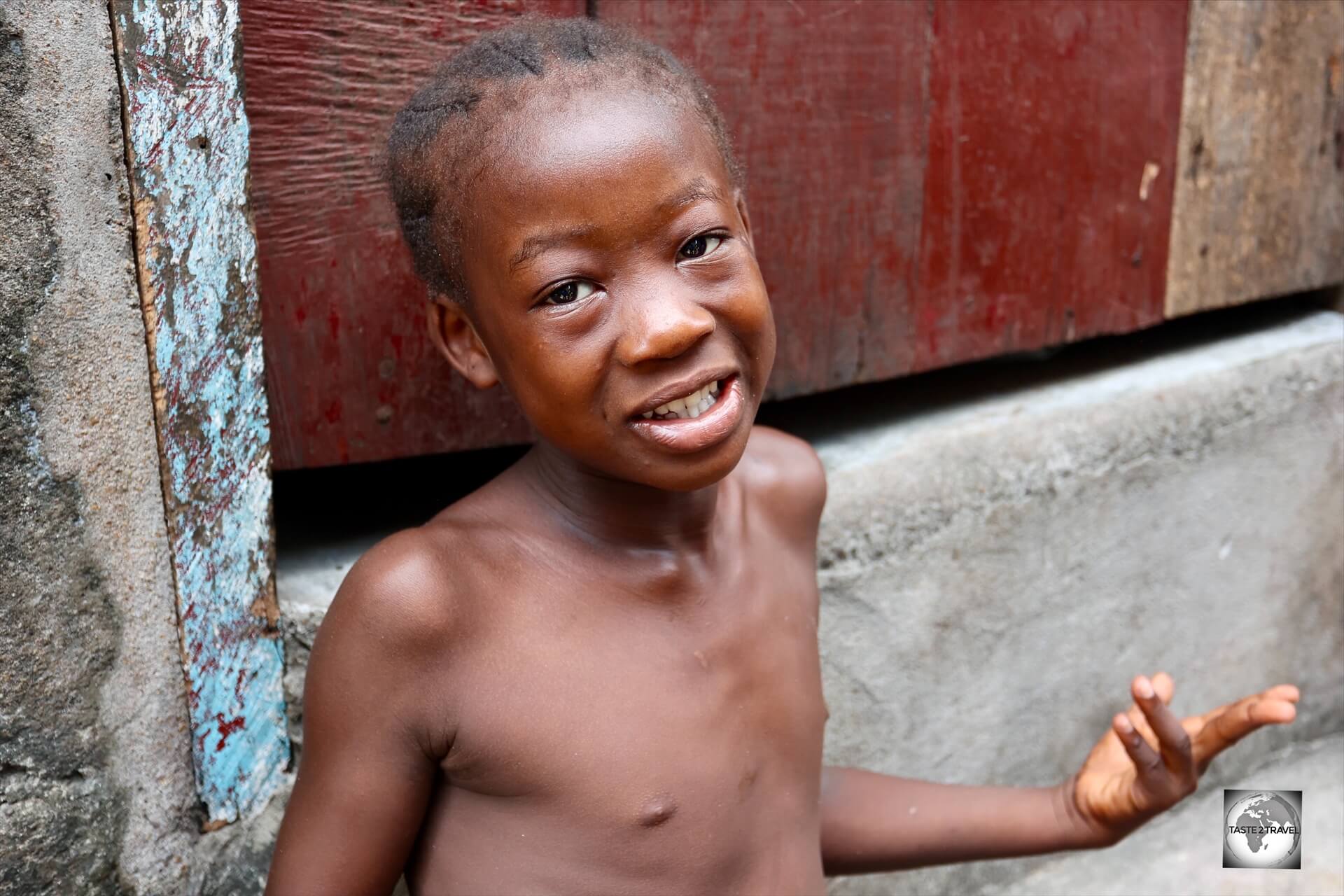
Lots of smiles from the friendly kids in West Point.
Sprawling West Point sits on a low-lying sandy peninsula with the beach at the front side and the Mesurado River behind.
One main road traverses this tightly-packed community. The road is bustling with market stalls selling fruits, vegetables, fish and anything else required by the local residents who have little to spend.
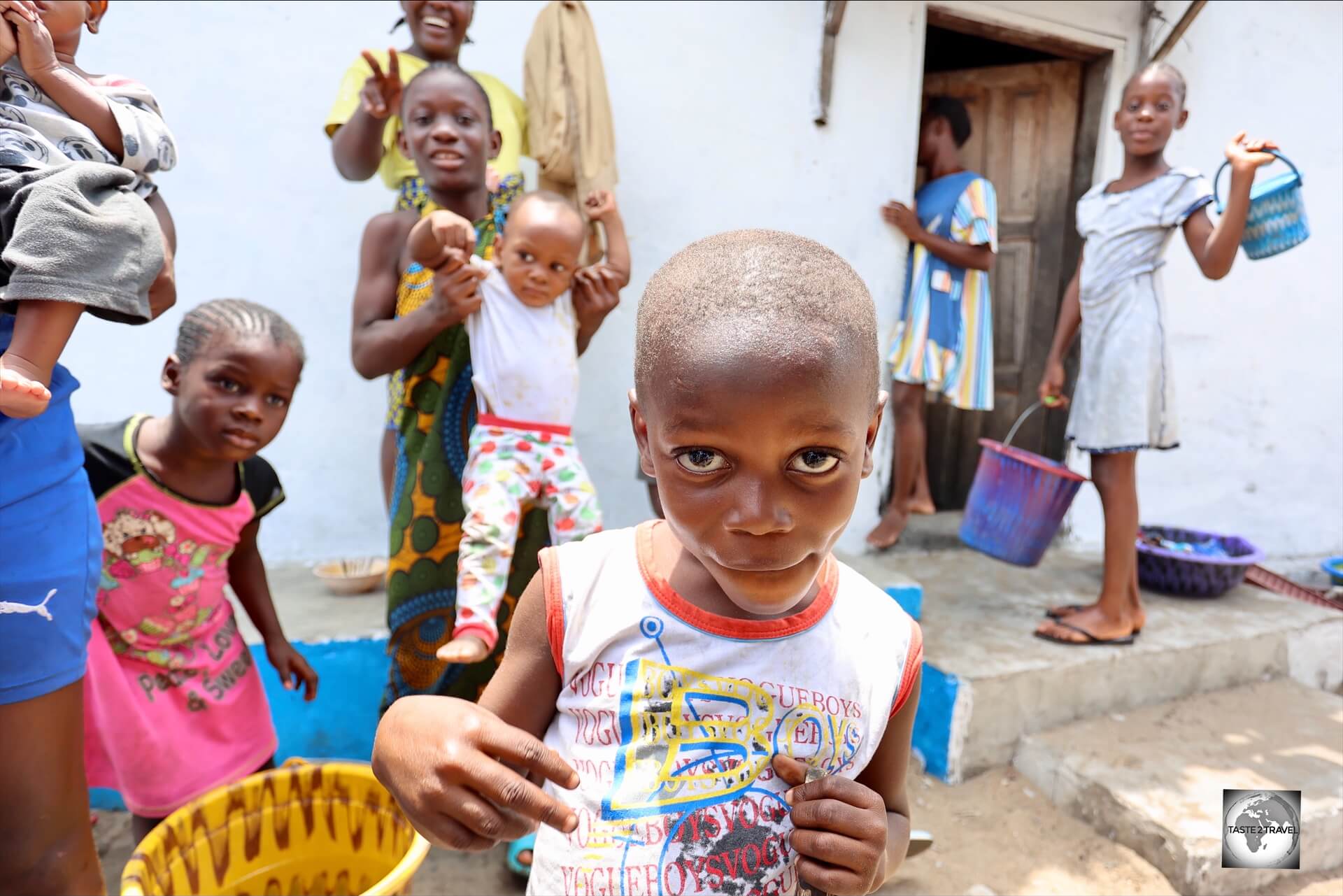
The playful kids of West Point.
We travelled along the main road in a tricycle which was an amazing experience.
Video: Riding, with Windell, in a tricycle, along the bustling main street of West Point, Monrovia.
Video: Riding, with Windell, in a tricycle, along the bustling main street of West Point, Monrovia.
Visting the Commissioner

Windell King, and the Commissioner of West Point, the Hon. Mcphearson Daweh.
The first part of our visit to West Point included a stop at the office of the Commissioner of West Point, the Hon. Mcphearson Daweh, who is the highest authority in West Point.
The Commissioner discussed the project and expressed his gratitude for Four Hunger’s freshwater pump project, which has been life transforming for the residents of West Point.
Walking through West Point
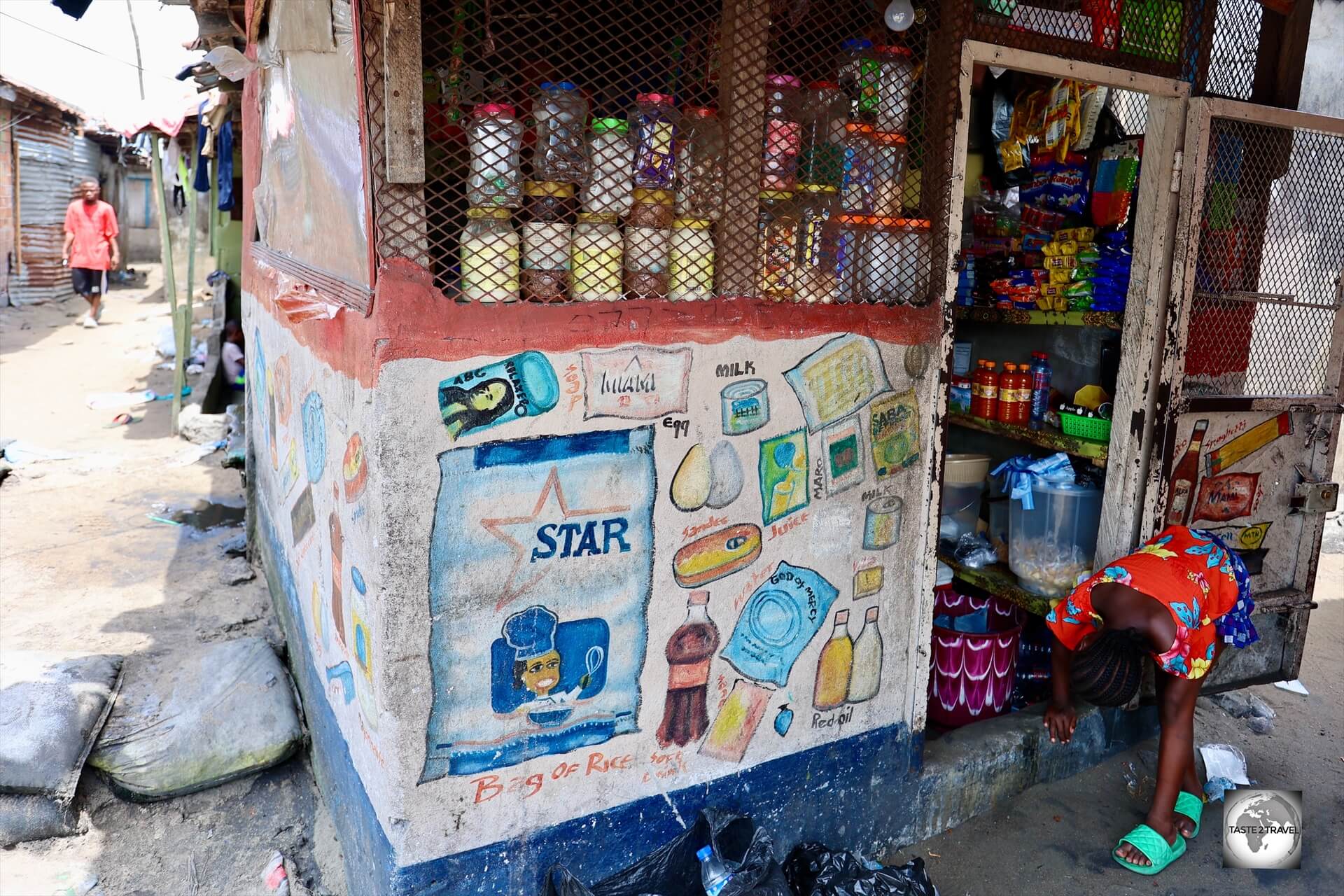
A corner store in West Point.
After leaving the Commissioner’s office, we proceeded through a rabbit-warren of narrow, sandy, laneways to the newly installed, freshwater pump #28.
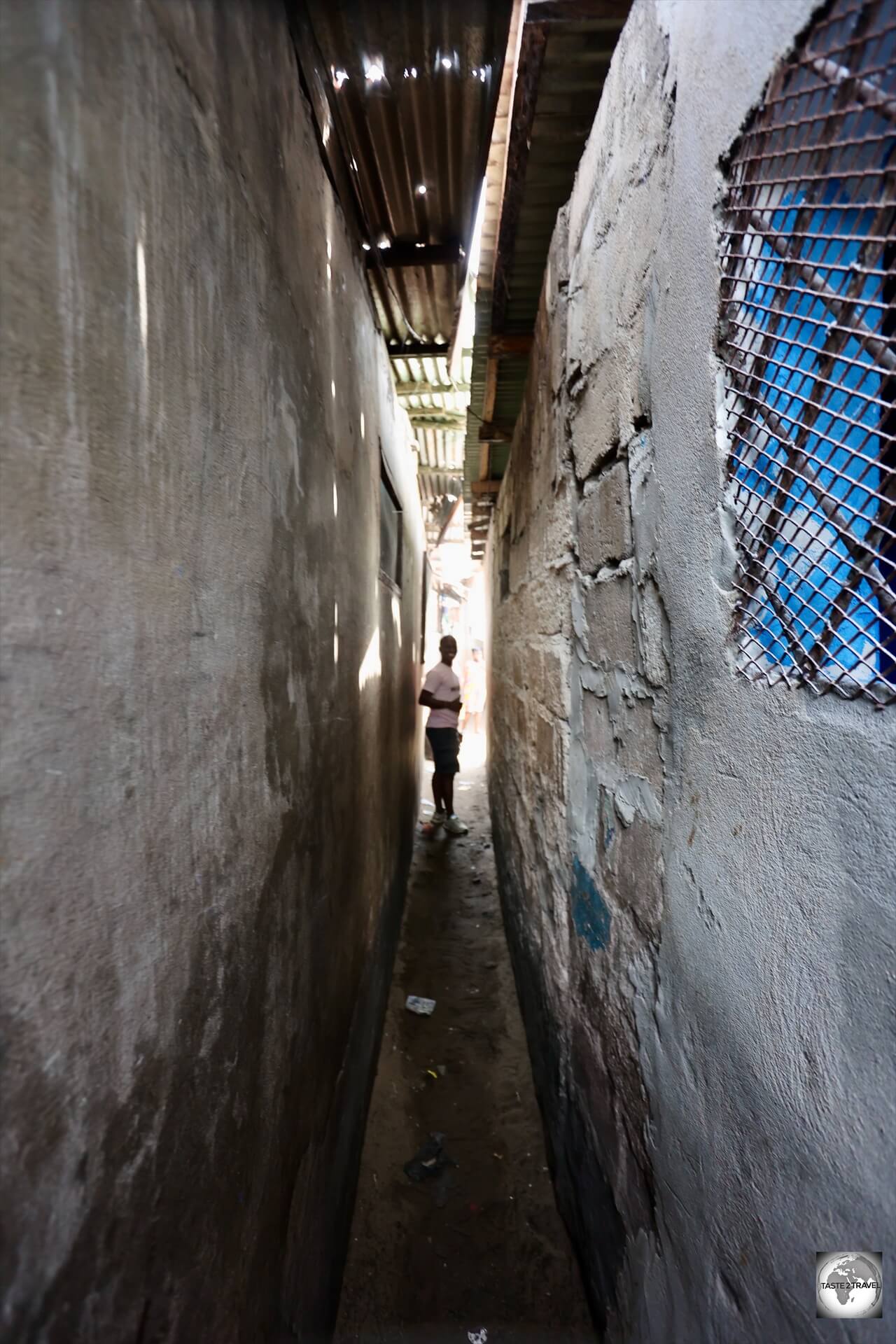
Windell King, leading me through one of the narrow laneways in West Point.
The locals of West Point were very friendly and welcoming and our arrival did cause a little commotion.
Video: Walking with Windell King through the tight laneways of West Point.
The Project

With Windell King at freshwater pump #28, which was sponsored in large part by Danish traveller Erik Futtrup and family.
We eventually reached freshwater pump #28 where more curious residents gathered.

The residents of West Point, which thanks to Windell and his team, now have access to fresh drinking water.
They too expressed their appreciation for the fact that they now have access to fresh water on their doorstep.
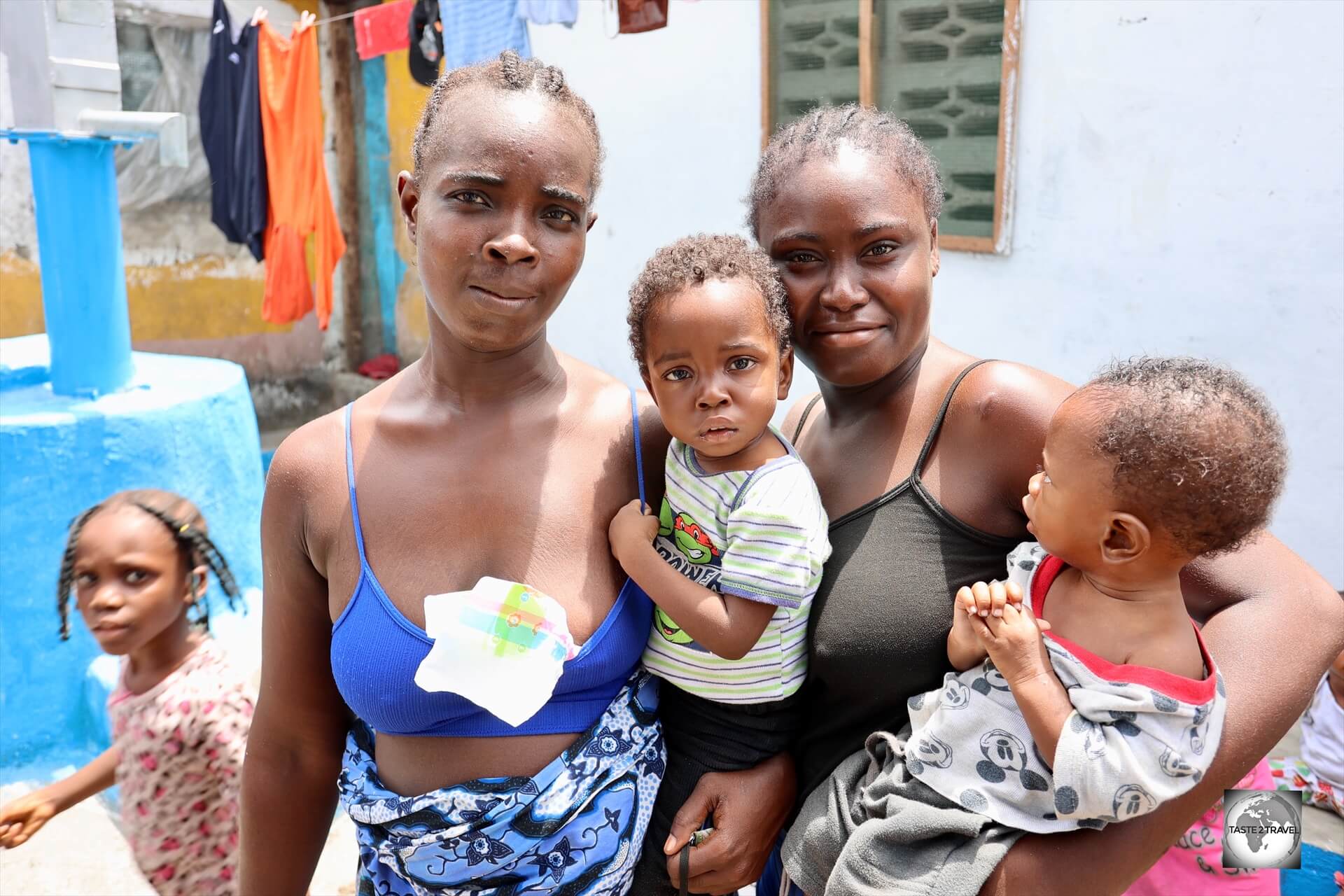
The residents of West Point gather around as we visit freshwater pump #26.
Life changing stuff!
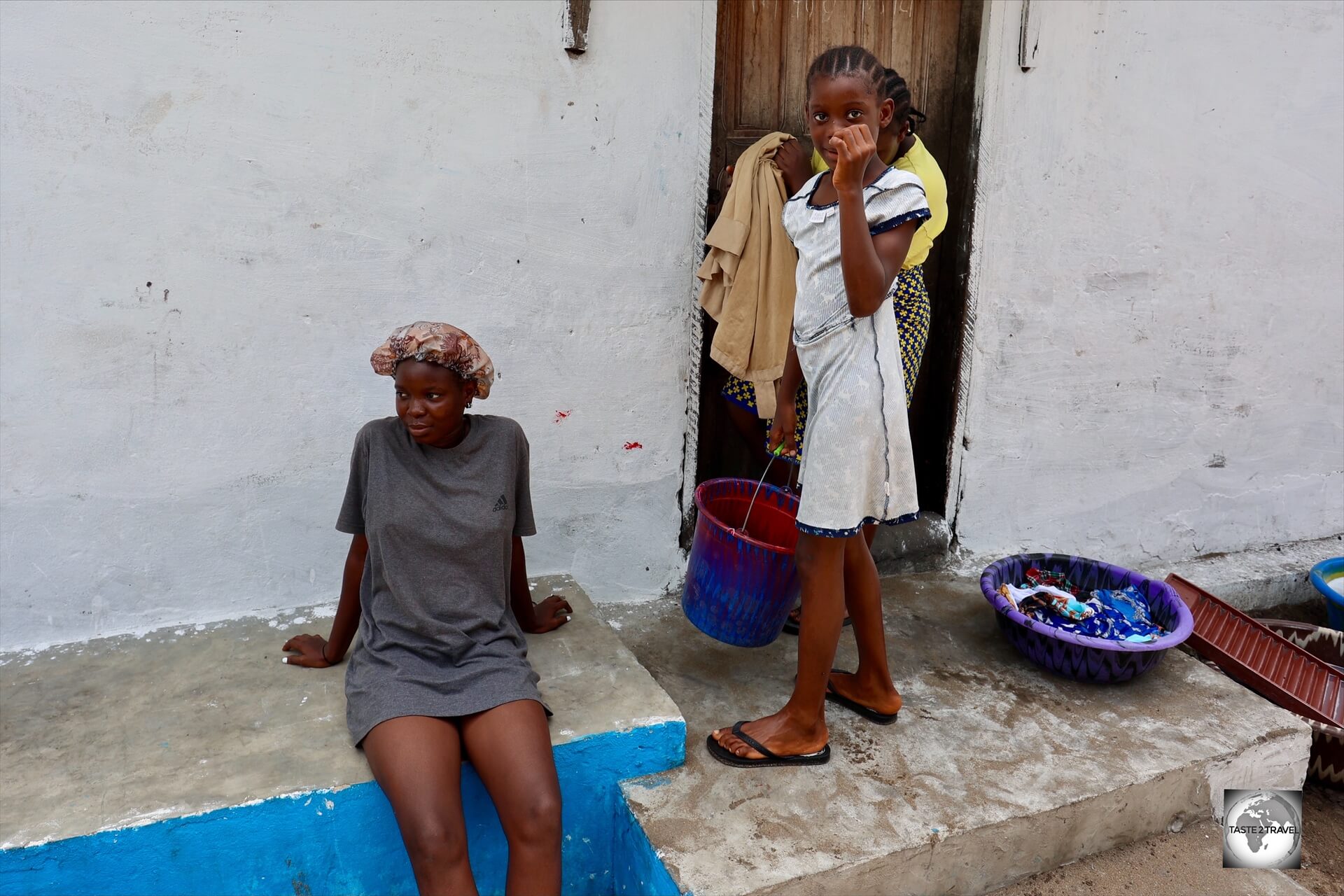
Life in West Point just got a little easier thanks to the installation of the new freshwater pump.
I conducted an interview with Windell at the pump, which is included below.
Video: An interview which I conducted with Windell King at Water Pump #26 in West point.
This is a well worthwhile project which is nearing its completion.
Never one to be lazy, Windell has advised that Four Hunger has identified a new project which will be to deliver freshwater pumps to the residents of Todee village which is located outside of Monrovia.
The residents of Toddee currently use dirty creek water for drinking, cooking etc.
Getting Involved
If you would like to get involved in a great direct-aid project, you can contact Four Hunger using the details below.
Four Hunger Contacts:
- Website: https://www.fourhunger.org/
- Instagram: https://www.instagram.com/fourhunger/
- Donations: https://donorbox.org/four-hunger-donations-1
- Windell King WhatsApp: +231 7785 06087
Tour Guide
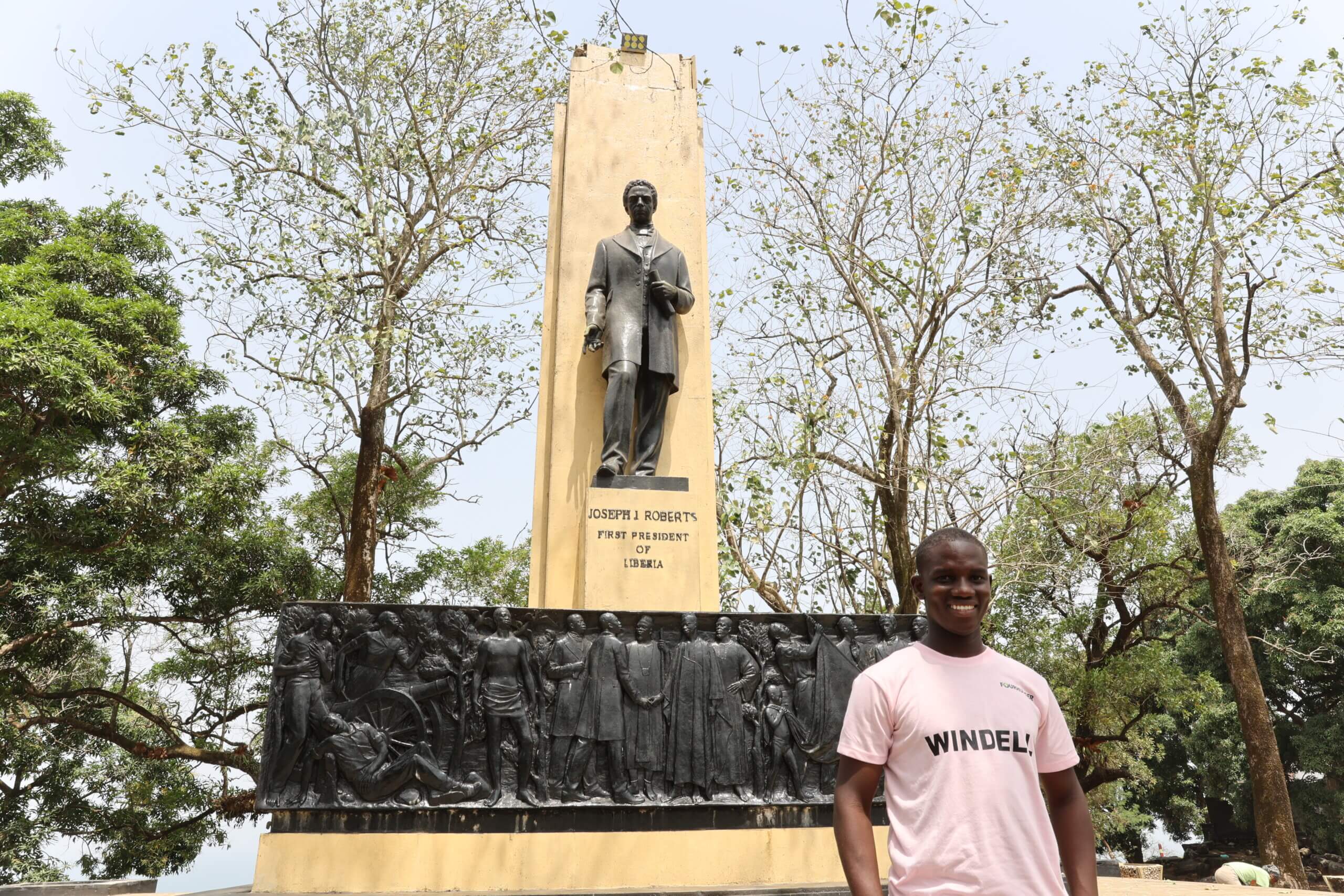
Exploring the sights of Monrovia with the wonderful Windell King.
I would highly recommend the amazing Windell King as a tour guide for your visit to Liberia.
Apart from being the co-founder of the incredible Four Hunger charity (as featured in the previous section), Windell is a font of knowledge when it comes to the sights of Monrovia and beyond.
I spent several days in the company of Windell, who showed me the sights of Monrovia and took me to see the latest water pump (#26) which had been installed by Four Hunger in the West Point slum. This was the highlight of my trip to Liberia!
Video: Walking with Windell King in downtown Monrovia!
Windell King Contact Details:
If you have any inquiries regarding tours, or the work of Four Hunger, you can contact Windell King at:
- Telephone/ WhatsApp: +231 7785 06087
- Email: windellsayonking@gmail.com
- Facebook: https://www.facebook.com/share/16UbJbYfU7/?mibextid=wwXIfr
- Instagram: https://www.instagram.com/windellking/
- YouTube: https://www.youtube.com/@windell_king
Sightseeing
Monrovia

Home to a third of the country’s population, Monrovia is the capital and largest city of Liberia.
Monrovia is the capital and largest city of Liberia.
The city was founded in 1822 by the American Colonization Society (ACS) as a settlement for freed American slaves.
The city is named after U.S. President James Monroe (served two terms from March 4, 1817 – March 3, 1825), reflecting Liberia’s historical ties to the United States, as the country was founded by freed American slaves in the 19th century.
Today, it serves as the political, cultural, and economic centre of the country.
The city has a population of 1,761,032 representing a third of Liberia’s total population.
The main thoroughfare of Monrovia is Ashmun Street, which is where you’ll find shops, banks, churches and the Liberian National Museum.
Ashmun Street is named after Jehudi Ashmun (April 21, 1794 – August 25, 1828), an American religious leader and social reformer from New England who helped lead efforts by the American Colonization Society to “repatriate” African Americans to Liberia.
Ducor Hotel

Once, one of the finest five-star hotels in Africa, the former Ducor Intercontinental Hotel is an abandoned luxury hotel which overlooks Monrovia.
Many years ago, long before the Liberian Civil War bought considerable death, damage, destruction and chaos to Liberia, Monrovia boasted one of the finest 5-star hotels in all of Africa.
The Ducor Intercontinental Hotel, originally named Ducor Palace Hotel, was Liberia’s first international-class hotel, built in 1960 by an Israeli industrialist, and later managed by InterContinental Hotels.
The hotel was built on top of Ducor Hill, the highest point in downtown Monrovia, and offered sweeping views in every direction.
Boasting 106 deluxe rooms on eight levels, a large swimming pool, tennis courts, and a French restaurant, the hotel was popular with tourists from the Côte d’Ivoire and Ghana, as well as visiting professionals from the US, Europe, and Asia.

The abandoned swimming pool at the Ducor Hotel, where Idi Amin is said to have swum while carrying his gun.
The hotel was a popular venue for meetings between African leaders and, on one occasion, it is said that Idi Amin, the former Ugandan dictator, an someone who is considered to be one of the most brutal despots in modern history, once went swimming in the pool while carrying his gun.
The hotel closed its door in 1989, just before the First Liberian Civil War, and suffered significant damage during the conflict.
The building endured much damage during the war, due both to the violence of the war and to looting.
During this time, displaced residents of many of Monrovia’s slums began to occupy the hotel’s empty rooms.
It has been abandoned since the hotel closed its door although there are rumours that it could be renovated and reopened again.
During my visit, a security guard showed me where engineers had taken concrete samples which were then tested to determine if the current concrete structure could be utilised in a new development.
Access: The hotel complex is fully locked and guarded by a couple of security guards who are happy to provide access and a, tightly controlled, wander around the premises in exchange for a tip.
Photography is strictly forbidden and the guards will keep an eye on you to ensure compliance!
Joseph J. Roberts Monument

Located on Ducor Hill, the Joseph J. Roberts Monument is dedicated to the first president of Liberia.
Located on Ducor Hill, next to the abandoned Ducor Palace Hotel, the Joseph J. Roberts Monument is dedicated to the first president of Liberia, who served from 1848 to 1856, and again from 1872 to 1876.
Joseph Jenkins Roberts was born in Norfolk in 1809 and later moved to Petersburg, Virginia, where his family ran a river transport business.
In 1829, Roberts and his family emigrated to the colony of Liberia, serving in various positions before becoming the first president.

Bronze relief plates at the Joseph J. Roberts Monument depict the life of Liberia’s first president.
The monument consists of a bronze statue of Joseph J. Roberts standing above a relief plate which tells the story of Joseph Roberts’ life.
The monument was officially unveiled in 1950, during a period when Liberia was highlighting its history and legacy as Africa’s first independent republic.
The bronze statue of J.J. Roberts was sculpted by Italian artists, as Liberia sought international craftsmanship to commemorate its most important national figure.
A family of ‘caretakers’ look after the enclosure, to which the entrance gate is normally kept closed.
The family will provide entrance in exchange for a small tip.
While you visit the site, the family will perform some cursory sweeping in order to justify any tip given.
Fort Norris Cannons

Cannons, from the former Dutch-built Fort Norris, are installed in front of the Joseph J. Roberts Monument.
Fort Norris, also located on Ducor Hill, was built by the Dutch before 1822, later taken over by the US Navy, and renamed Coastal Battery Fort Norris.
The cannons from the fort are installed in front of the Joseph J. Roberts Monument.
Liberian National Museum
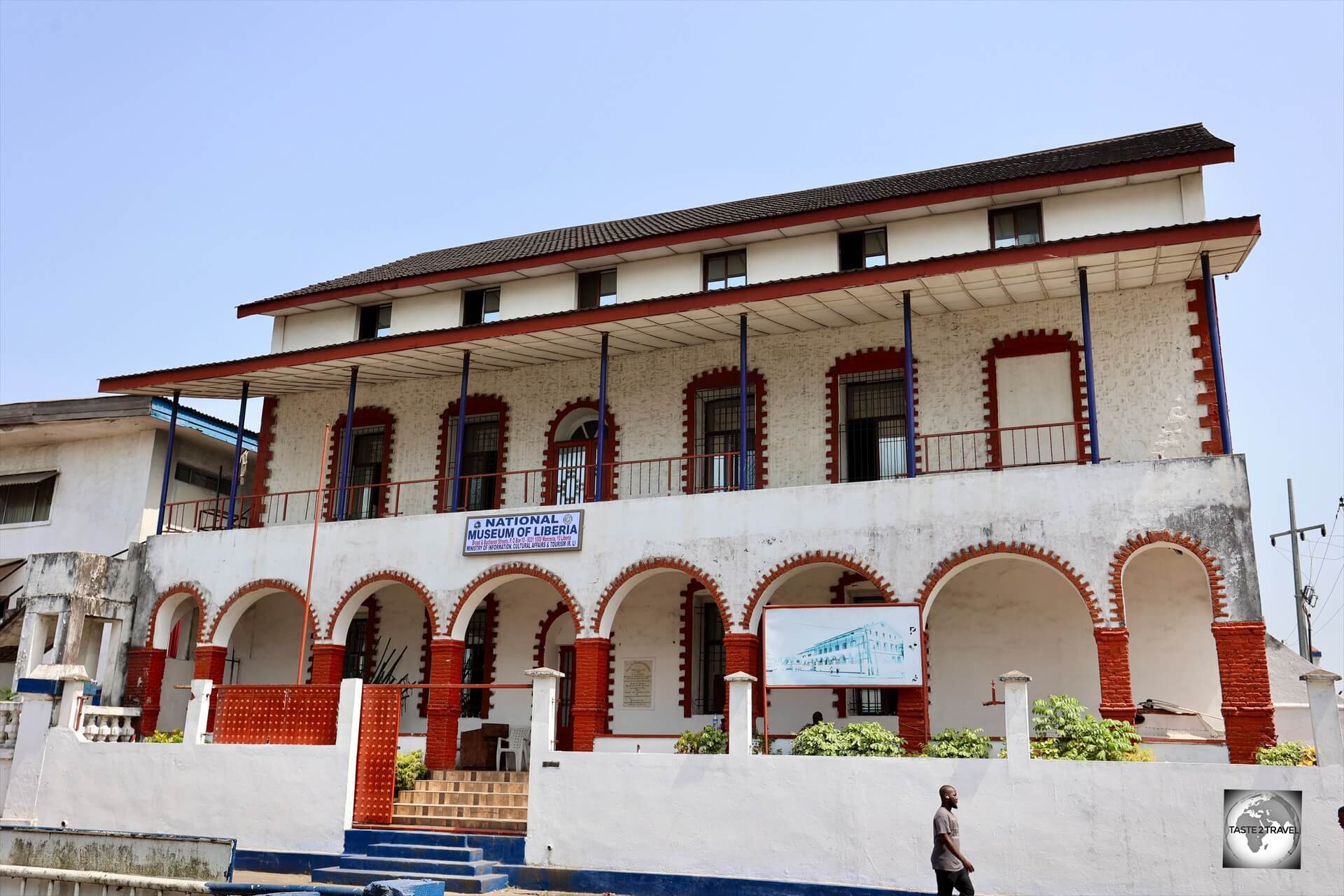
Housed in the former First Executive Mansion on Ashmun Street, Monrovia, the National Museum of Liberia is the only museum in Liberia.
The National Museum of Liberia is the national museum which is located on Ashmun Street, Monrovia.

A view of the ground floor of the Liberian National Museum, the only museum in Liberia.
The museum was established in 1958 under the administration of Liberia’s 18th President, Dr William V.S. Tubman.
Moved several times, the current museum has been housed since 1987 in the former Supreme Court building.
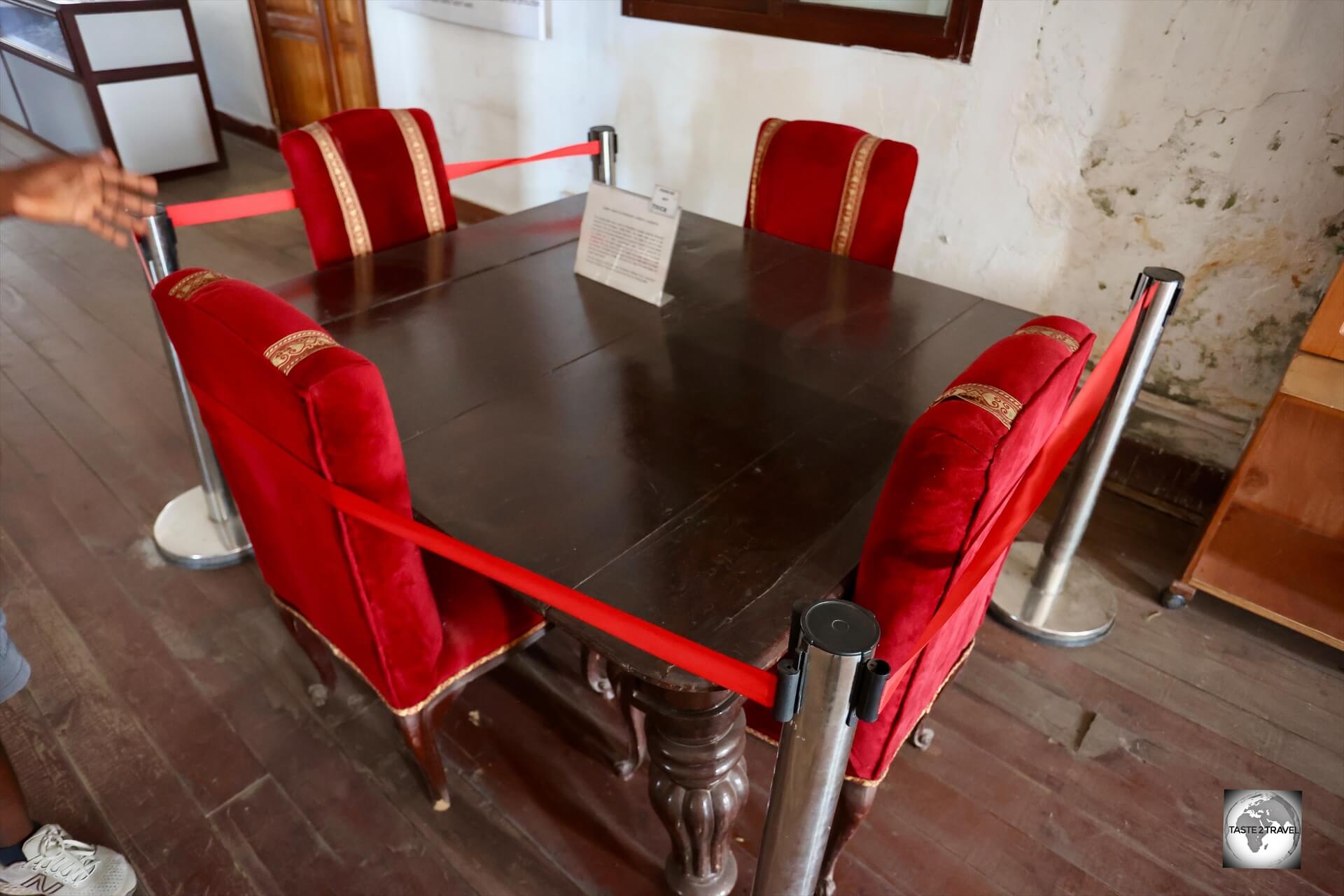
On display at the Liberian National Museum is this 250-year-old dining table which was given as a gift from Queen Victoria to Liberia’s first President, Joseph Jenkins Roberts.
The museum occupies three floors with the ground floor devoted to the history of Liberia.

This fertility statue is a highlight of the Ethnographical Gallery at the Liberian National Museum.
On the next floor is the Ethnographical Gallery and on the top floor the contemporary arts gallery which illustrates Liberian artistic works many of which are product of a contract between the museum and art institutions and art colleges throughout the country where artists are commissioned to produce for the museum purposes.
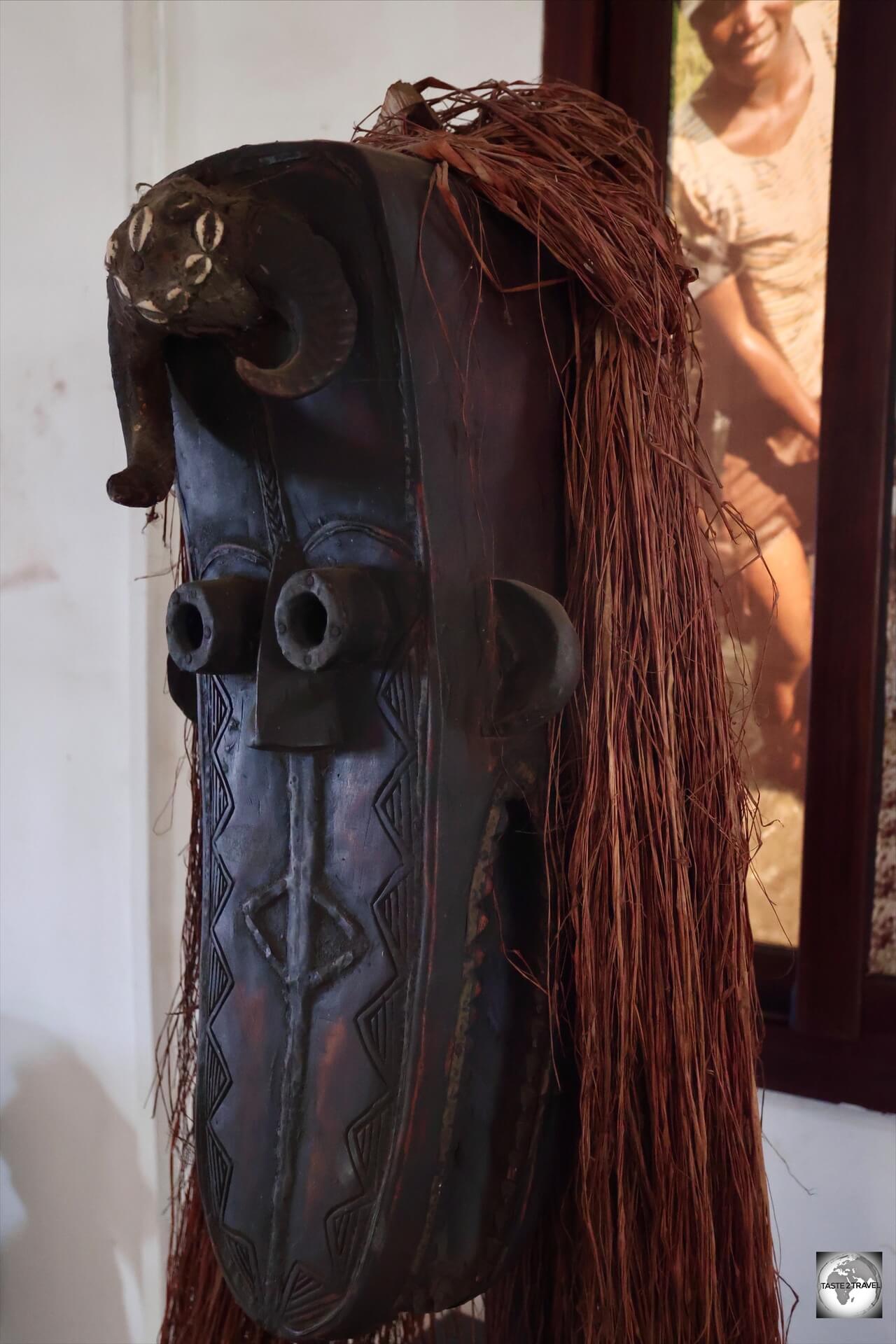
One of many traditional masks which are displayed at the Liberian National Museum in Monrovia.
The museum was hugely affected by the 14-year-long Civil War when approximately 5,000 artifacts were looted.
Now, just 100 larger artifacts remain.
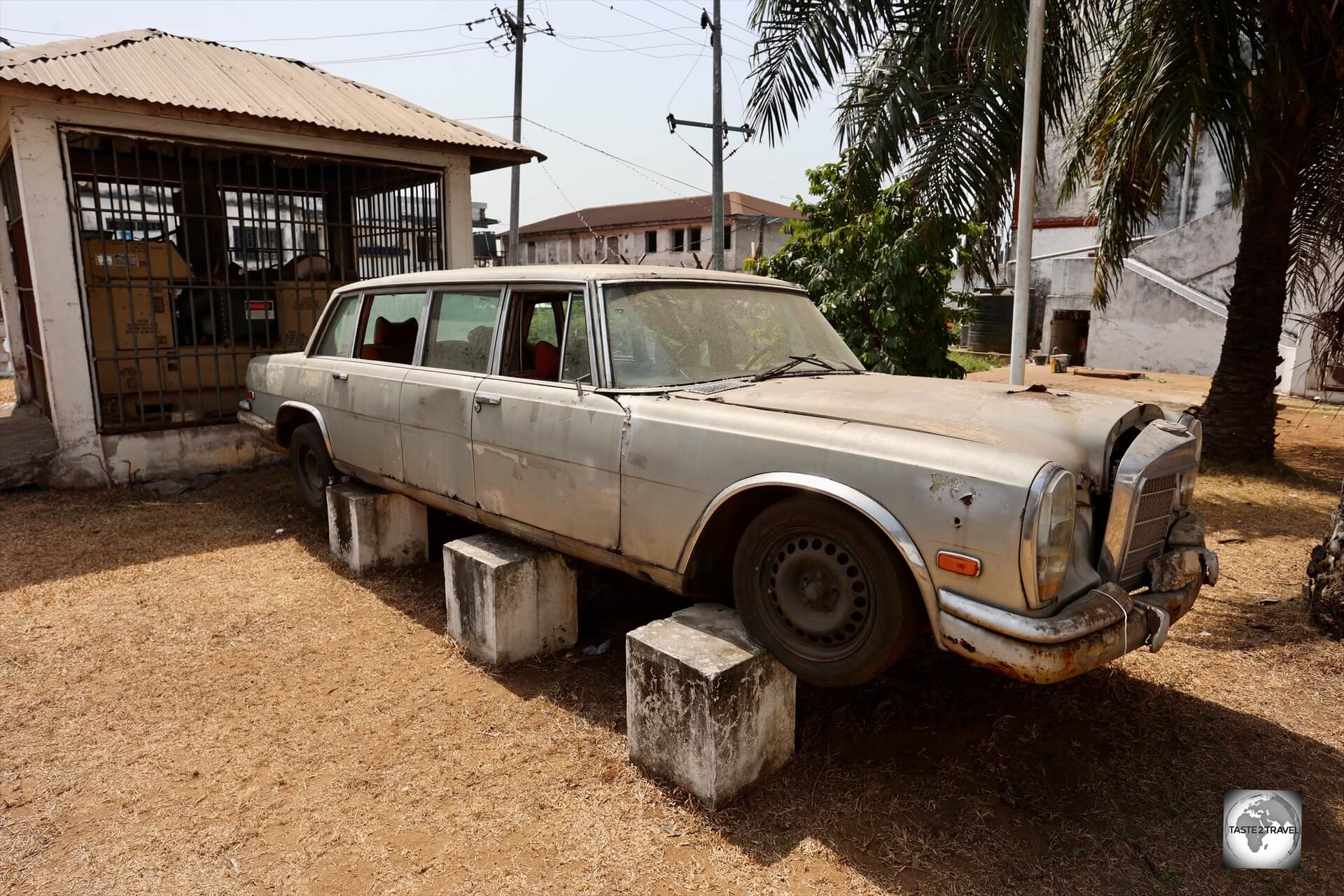
The limousine of President Tubman, the 19th president of Liberia and the longest-serving president in the country’s history, at the Liberian National Museum.
On the museum grounds, visitors are able to see several presidential limousines used by presidents Tubman and Doe and the famed bulletproof Mercedes, which was a gift from Colonel Gaddafi to Charles Taylor (pictured above in the ‘History‘ section).
United Methodist Church

The United Methodist Church was founded in 1822 by freed slaves.
Closed during my visit, the United Methodist Church, on Ashmun Street, was founded in 1822 with the arrival of black immigrants from the United States.
Among its early members was Joseph Jenkins Roberts, who served as the first president of Liberia.
The United Methodist Church in Liberia is a member of the United Methodist Church, one of the world’s largest denominations.
It is part of the Wesleyan Tradition, a methodical faith and practice started by John Wesley, whose father was a priest in the Anglican Church in England.
Accommodation
Monrovia
The Cape Hotel

While not cheap, the popular Cape Hotel offers a safe, secure environment with very good rooms, a decent restaurant, swimming pool and gym.
During my stay in Monrovia, I chose to stay at the excellent The Cape Hotel which is a very secure, 5-star hotel, located at Mamba Point.
Surrounded by security walls and well-guarded, the hotel is located across the road from the beach and around the corner from the very large United States Embassy.
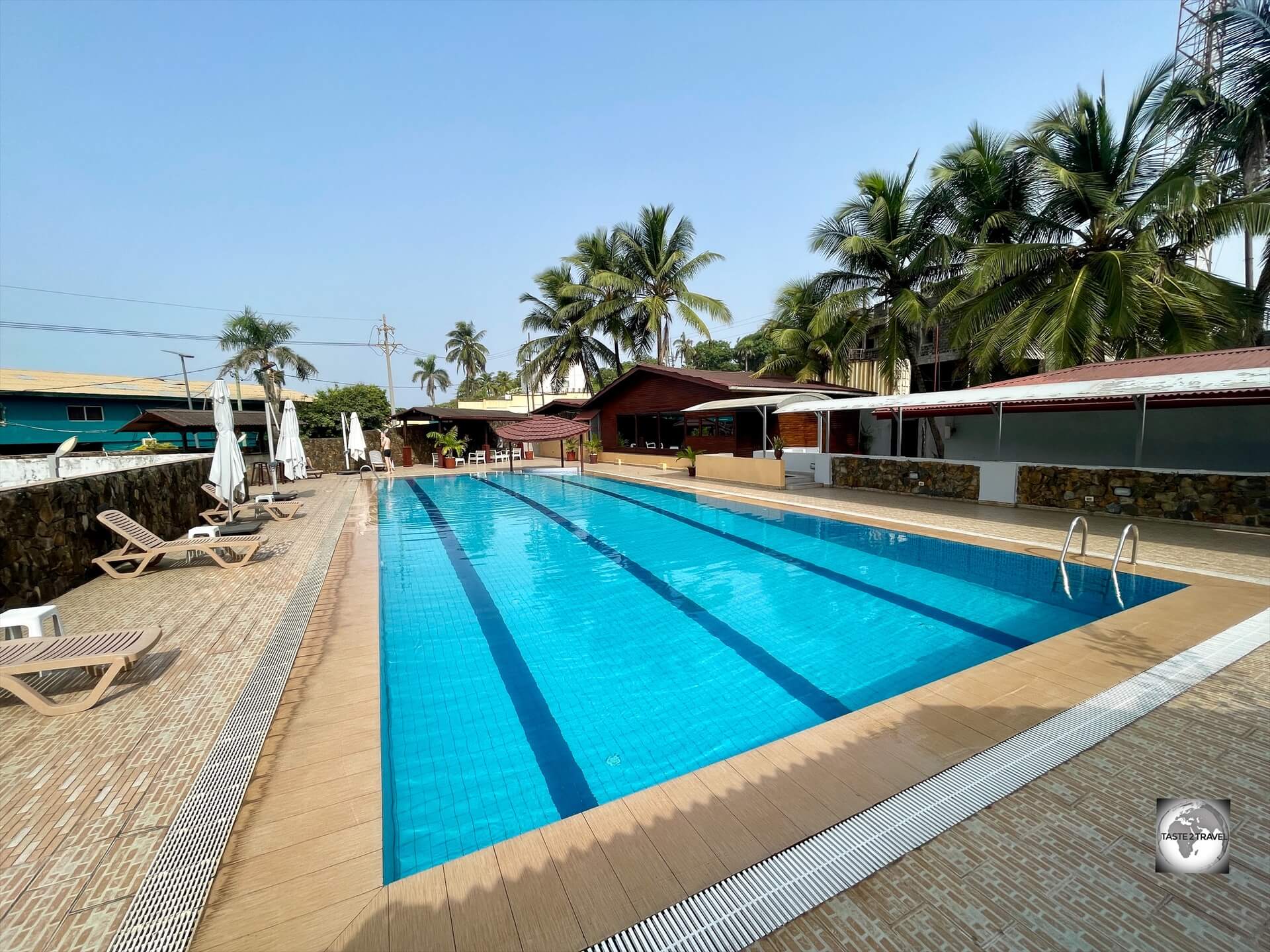
The wonderful swimming pool at The Cape Hotel was never busy.
Security is paramount in a country like Liberia and The Cape Hotel is certainly very secure.
The hotel is set inside its own compound which has security guards posted at both the entry and exit gates.
Security guards are also posted on the main doors of both the hotel building and the restaurant building.
This abundance of security allows guests to truly relax while at the hotel.
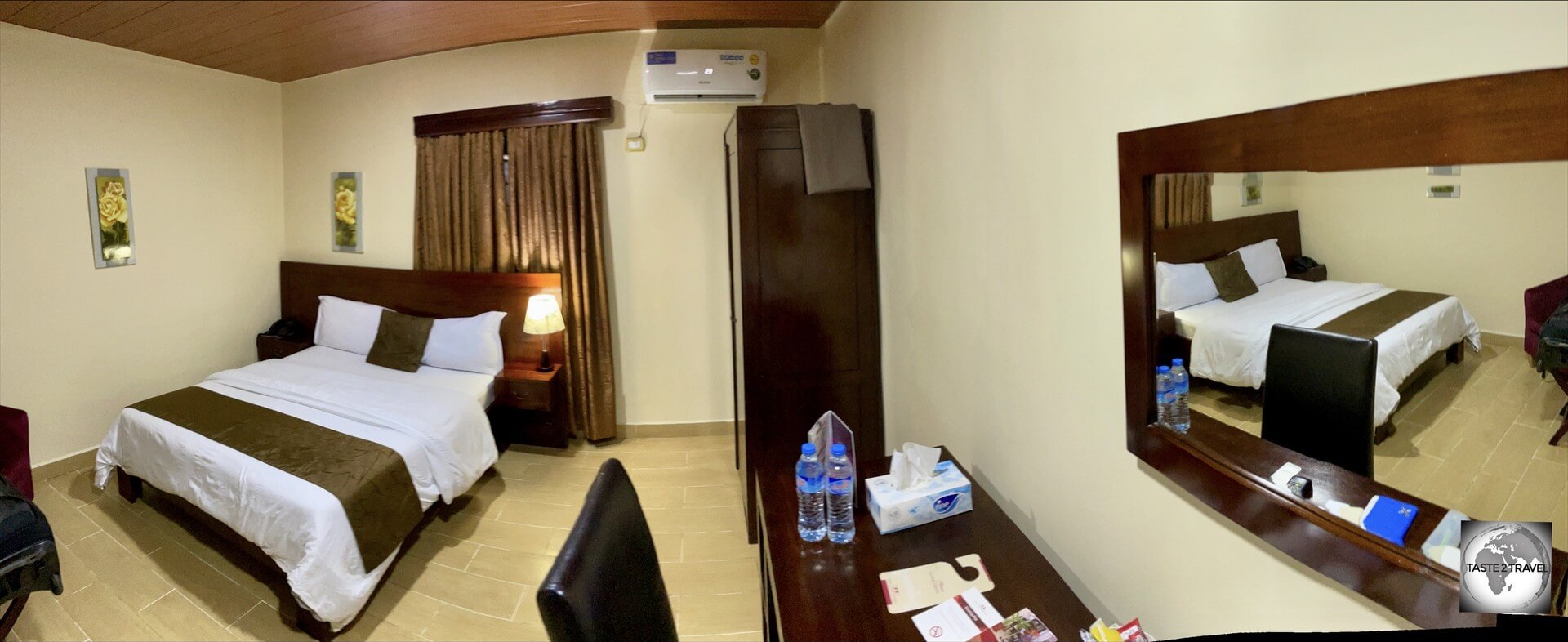
My room at The Cape Hotel, a standard single room.
As per the Accommodation page of the hotel’s website, the hotel offers rooms, apartments and suites, which range from US$170 up to US$600 for the Presidential suite.
I stayed in the cheapest room, a standard single which cost me US$170 per night.
Rooms include a very fine buffet breakfast.
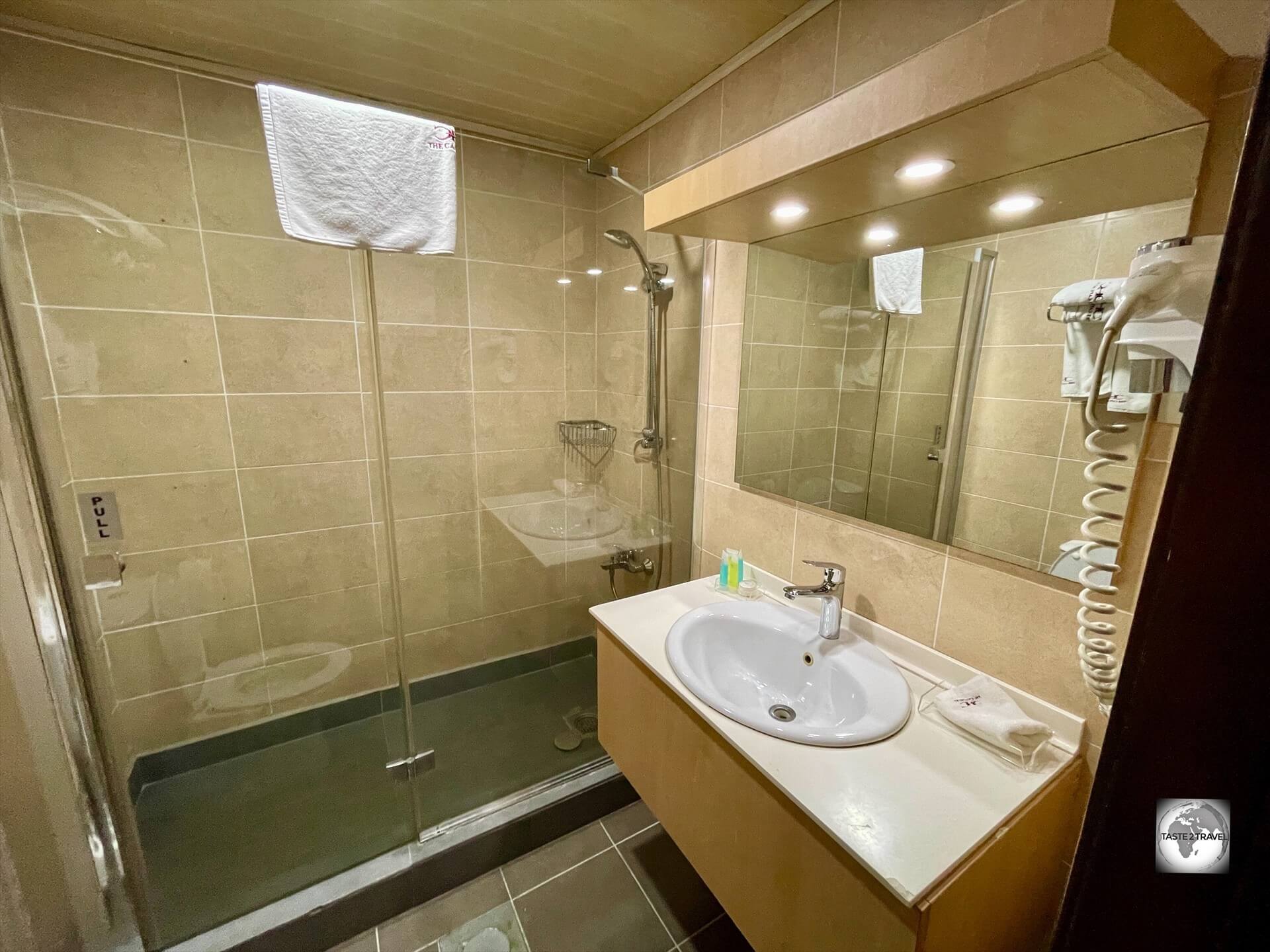
A view of my bathroom at The Cape Hotel.
Power outages occur frequently in Liberia with the power often being down for extended periods of time.
However, this was never a problem at The Cape Hotel which is equipped with a large generator which seemed to be on more than it was off!

Facilities at The Cape Hotel include a gym and swimming pool.
The hotel also features the very popular The Cape Hotel Restaurant whose menu includes many Lebanese specialities which are prepared by the Lebanese head chef, who has lived in Liberia for about 25 years (see the ‘Eating Out‘ section below for more details).
The hotel also includes a very fine swimming pool (almost Olympic size), which is only busy on the weekend, and a fitness centre.
Eating Out
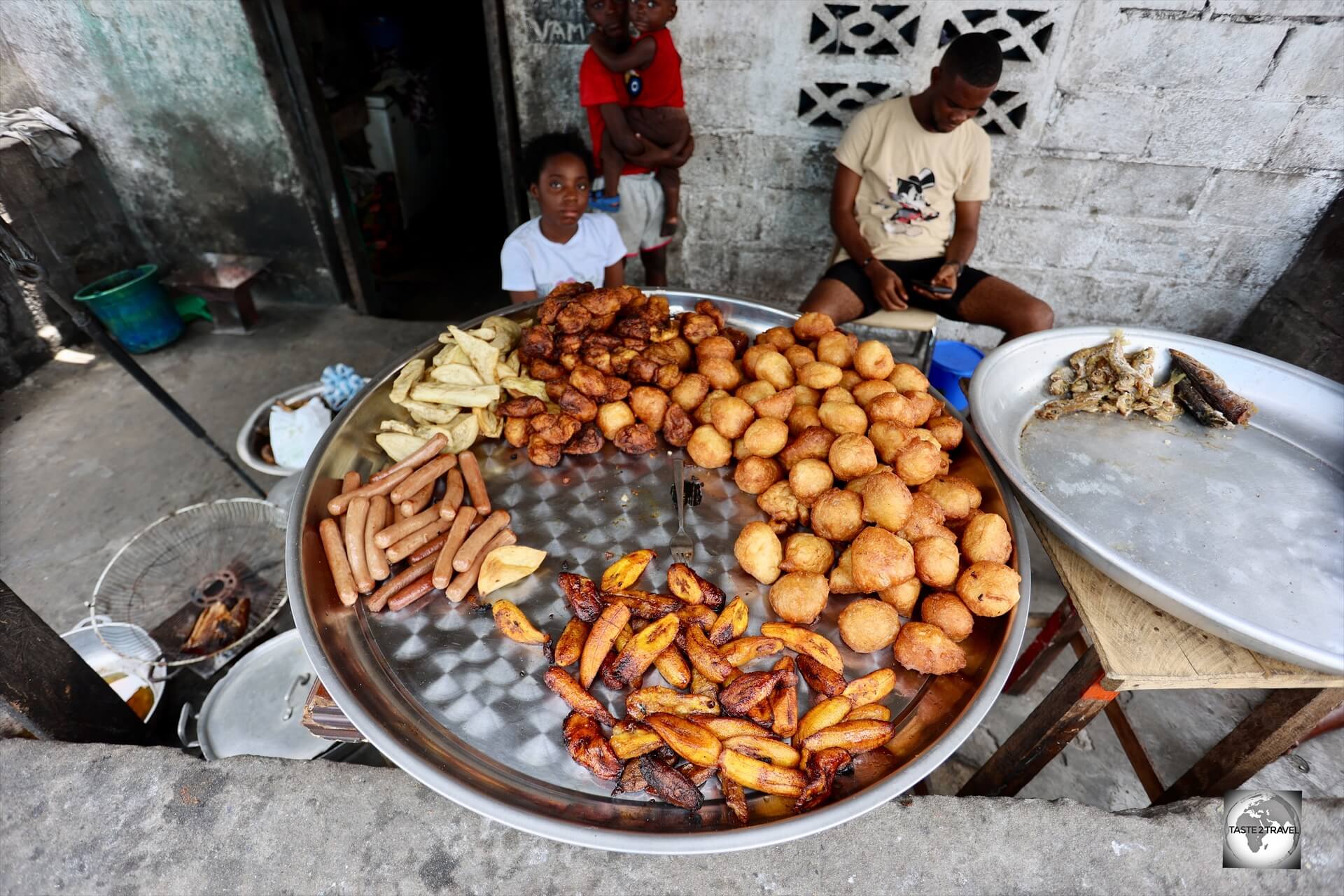
Street food, known locally as ‘Calla’ in West Point, Monrovia.
Liberian cuisine, a blend of West African and Creole traditions, features stews, soups, and rice-based dishes, often with seafood, meat, and vegetables, and is known for its spicy flavors and starchy staples like rice, cassava, and plantains.
As with other African countries, Chinese and Lebanese immigrants have opened restaurants which offer an alternative to the local cuisine.
Restaurants

A fine lunch of grilled fresh fish and mashed potato at The Cape Hotel in Monrovia.
Since I was staying the The Cape Hotel who have an excellent restaurant – The Cape Hotel Restaurant – I ate many meals at the hotel.

The Lebanese chef at The Cape Hotel Restaurant prepares superb Lebanese cuisine.
The kitchen is under the command of Shad Greg, the F&B Manager, and a Lebanese ex-pat who has been resident in Liberia for many years.
The restaurant offers a menu of international food, Liberian and Lebanese cuisine.
I especially reccommend any of the Lebanese dishes, including the chicken shish which is served with a fresh salad and home-made flat bread.
The local grilled fish, served with loads of mash potato, was also excellent.
Delicious!
Bars

Enjoying a Club Beer at a beach bar in Monrovia.
Monrovia Breweries keep the country satiated with their very popular Club Beer, a refreshing lager which is brewed using malt imported from Denmark.
Wherever you go in Liberia, Club Beer will be on offer.
Visa Requirements
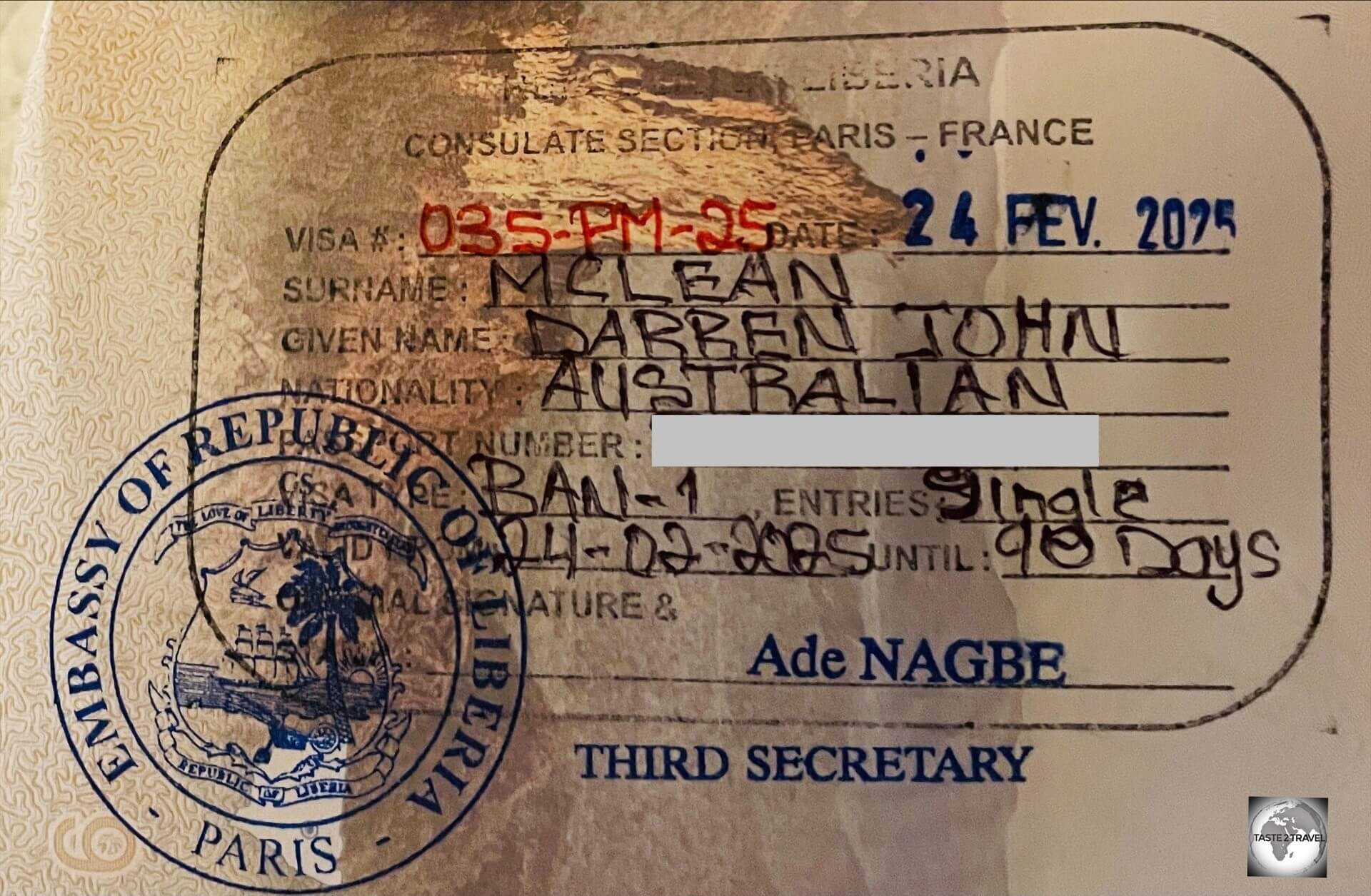
My Liberian visa which was issued at the Liberian embassy in Paris.
Most visitors to Liberia need to apply in advance for a visa.

The Visa Policy Map for Liberia with countries highlighted in grey needing a visa.
As per the Visa Policy Map, passport holders from the grey countries need to apply for a visa in advance while those countries highlighted in blue (ECOWAS citizens) are visa exempt.
Visas can be obtained via the Liberian eVisa Portal for US$180.
Alternatively, visas can be obtained from a Liberian embassy.
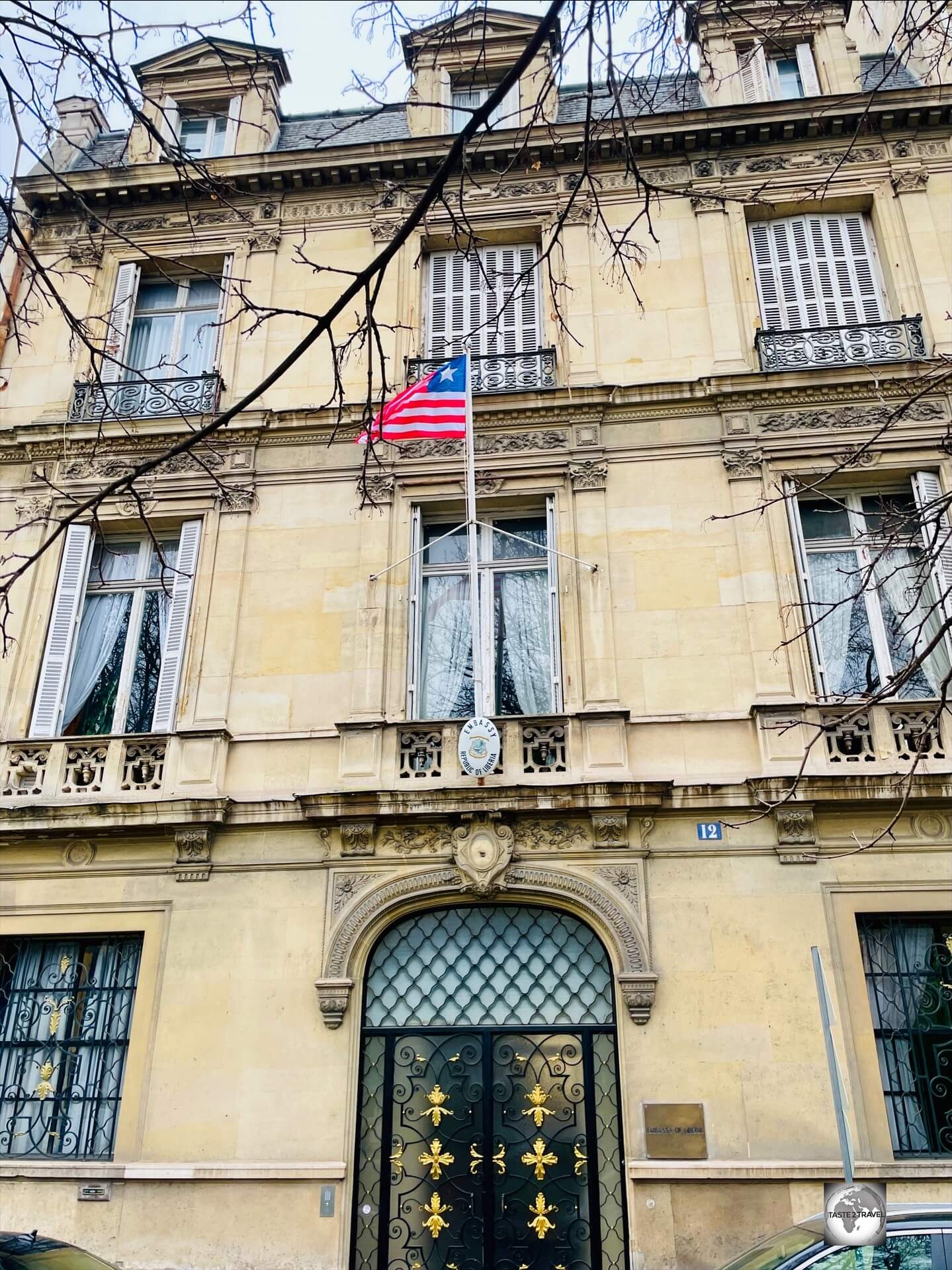
The Liberian embassy in Paris.
I applied for my visa at the Liberian Embassy in Paris where the friendly staff issue a 90-day single-entry visa for €100 (7 business days processing), or €150 for express service (3 business days), without any fuss.
The beautiful embassy building has been owned by the Liberian government since the 1940’s.
If applying at the embassy in Paris, it’s best that you pre-check the Visa Application Requirements before visiting the embassy to ensure you bring all the required documents.
Prior to visiting the embassy, it’s best to print two (2) copies of the Visa Application Form and have these ready to hand in when you apply.
Note: You will need to show your Yellow Fever Vaccination Certificate when applying for your visa and also on arrival in Liberia.
To check your requirements, you should refer to the Visa Policy of Liberia.
Paris Embassy Contact Details:
- Website: https://embassyofliberia-paris.org/
- Email: libem.paris@wanadoo.fr
- Address: 12, Place Du General Catroux, 75017 Paris, France
- Nearest Metro Stations: Malesherbes and Villiers
- Telephone: (+33) 1 47 63 58 55
Getting There
Air

Brussels Airlines offer one of the very few connections to Monrovia, several times a week, with flights also stopping at either Abidjan or Freetown.
Located 2-hours east (56 km/ 35 mi) of downtown Monrovia, Roberts International Airport (IATA: ROB) is the only international gateway to Liberia.
The airport is named in honor of Joseph Jenkins Roberts, the first President of Liberia.
A project, which was funded by the Chinese and Saudi governments, saw the building of a new, modern, 2-level, terminal which includes two air bridges. The terminal commenced operations in 2019.
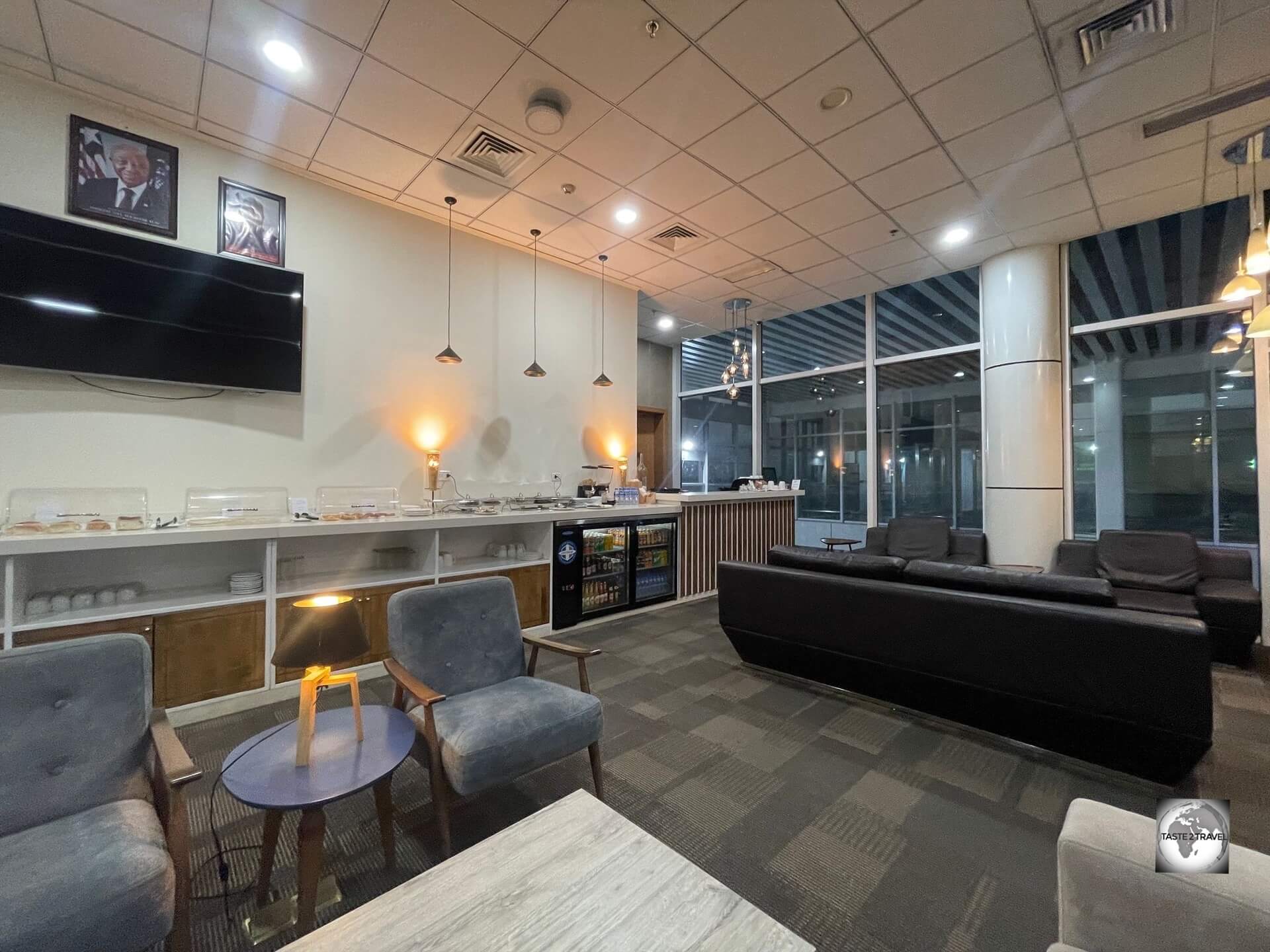
The comfortable business-class lounge at Roberts International Airport.
The new terminal includes a comfortable business-class lounge which is also available to economy-class passengers who are charged a US$30 usage fee (credit cards accepted).
The reason the airport is located so far from town is that it was never built as a public facility but was built by the U.S. military as an Air Force base for use during World War II.
The base was originally used by the US military for refuelling large bomber planes and as such, when it opened, the airport boasted the longest runway in Africa at 3,353 metres/ 11,000 feet.
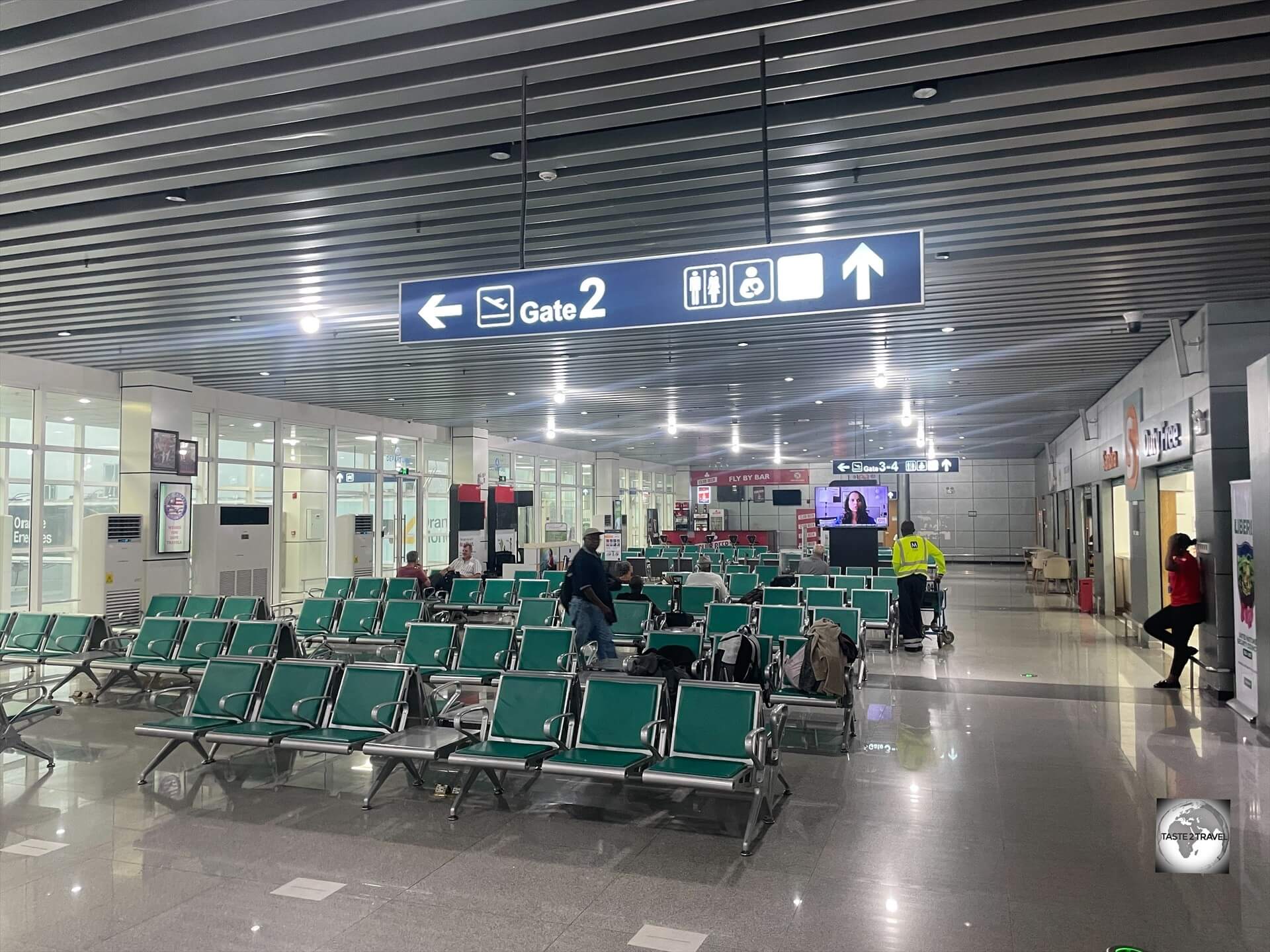
The departure area at Roberts International Airport, the only international airport in Liberia.
For many years, Pan Am used the airport as its base for flights between the United States and various destinations in Africa.
The airport is a much quieter place today, being served by just 7 airlines, with 6 being African carriers, offering flights to other African destinations, with connections beyond Africa.
The sole non-African carrier serving Monrovia is Brussels Airlines.
Brussels Airlines
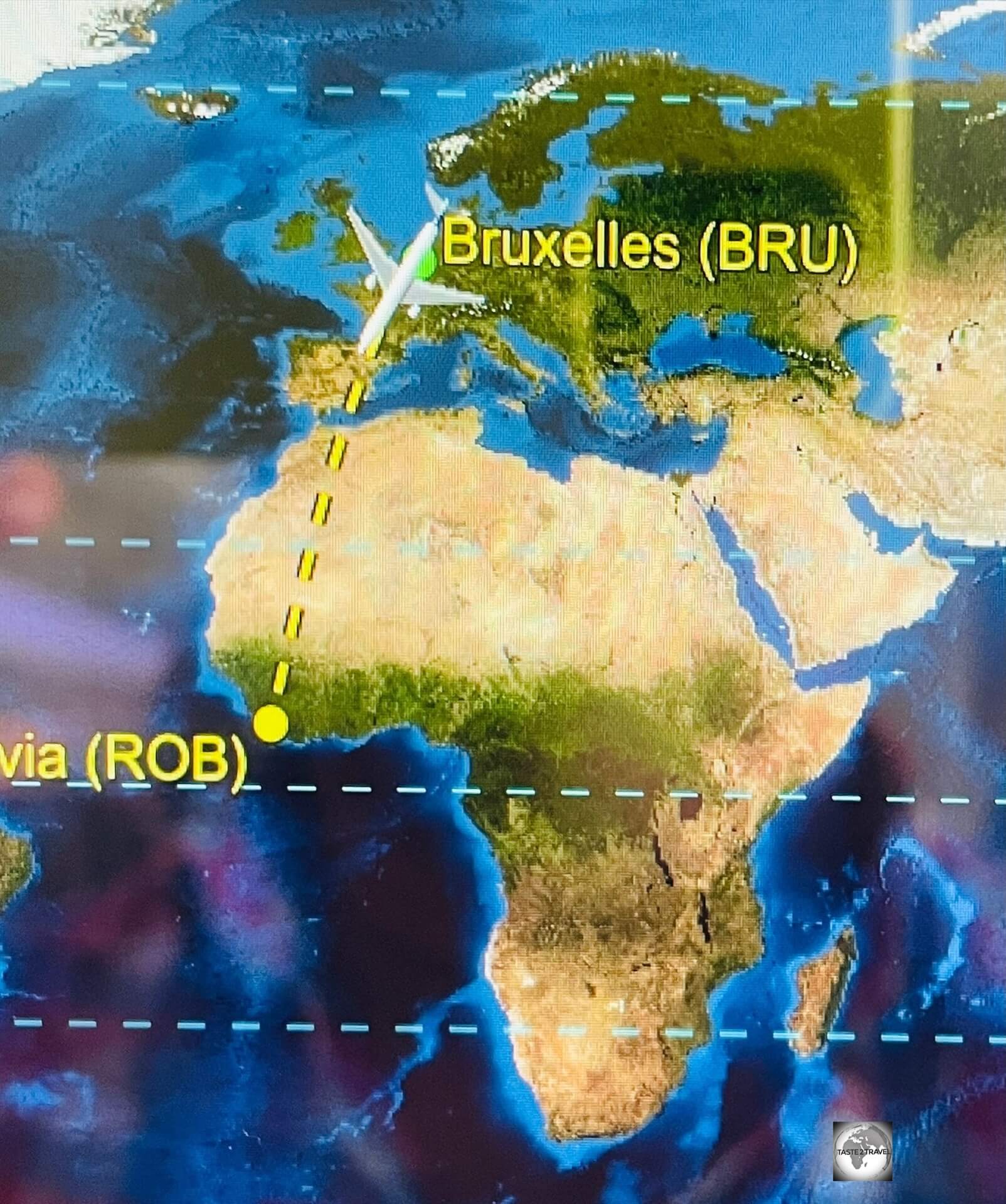
Brussels Airlines offer the only direct connection between Liberia and Europe.
Brussels Airlines flies several times per week between its base at Brussels International Airport (IATA: BRU) and ROB with stopovers in either Freetown (Sierra Leone) or Abidjan (Côte d’Ivoire).
On both of my flights, most of the passengers were US citizens (many from the Liberian community living in the US) whose only way to reach Liberia from the United States was through Brussels Airport.
Upon my return to Brussels, only myself and one other passenger exited into Belgium, with all other passengers connecting to other international flights, mostly to the United States.
The flights operate under flight codes SN307 and SN241 with the following routing:
- Flight SN307 flies from Brussels to Monrovia, then onto Abidjan before returning to Brussels.
- Flight SN241 flies from Brussels to Freetown, then onto Monrovia before returning to Brussels.
If you wish to fly direct each way (as I did) you need to fly to Monrovia on flight SN307 and return to Brussels on flight SN241.
While in Monrovia, the airline crew are housed at the The Farmington Hotel which is located directly opposite the airport, far from downtown Monrovia.
Scheduled Flights
The following airlines operate scheduled services to/from Roberts International Airport:
- Air Côte d’Ivoire – flies to/ from Abidjan, Conakry
- Air Peace – flies to/ from Accra, Lagos
- ASKY Airlines – flies to/ from Abidjan, Accra, Banjul, Lomé
- Brussels Airlines – flies to/ from Brussels, Freetown, Abidjan
- Ethiopian Airlines – flies to/ from Addis Ababa, Conakry
- Kenya Airways – flies to/ from Accra, Nairobi–Jomo Kenyatta
- Royal Air Maroc – flies to/ from Casablanca
Airport Transport
The 56 km (35 mi) drive between the airport and downtown Monrovia takes about 2-hours due to the condition of the road, road works and traffic.
The Chinese government is currently building a 4-lane highway to connect the airport with Monrovia, with still much work to be done.
Hotels offer shuttle services for around US$50 – $70 while taxi operators charge US$50.
Land
Liberia shares land borders with Sierra Leone to the northwest, Guinea to the north and Côte d’Ivoire (Ivory Coast) to its east.
The following border crossings are currently open:
Guinea:
- Ganta: Ganta is a transit point for those traveling to and from southeastern Liberia, Ivory Coast, and Guinea.
Bolonguidu: In 2020, the road between Voinjama and Bolonguidu was rehabilitated, making it easier to cross the border. - Yeala: During the rainy season, canoes are used to cross the stream (Muleyea).
- Solumba: The closest town on the Liberian side is Solumba (3.4 km) from the border, and the closest town on the Guinea side is named Kessaney (1.5 km) from the border point.
Sierra Leone:
- Mendicorma: The nearest town or city to the Mendicorma border crossing is Foya City, which is 16 km away.
Cote d’Ivoire:
- Loguatuo: The road access to Loguatuo is muddy but passable throughout the year.
- Pleebo: Pedebo is a small city of the Pleebo district in Maryland County, about 15 km away from Harper town.
Sea
Although Monrovia is a port city, it is not a destination for cruise ships.
Getting Around
Video: Riding in a tricycle through West Point Monrovia – a great way to explore Monrovia!
In Liberia, public transportation primarily consists of buses, shared taxis and tricycles within and around Monrovia.
The National Transit Authority (NTA) is working to improve public transportation, including adding new routes and buses, but road conditions can be challenging, especially outside of Monrovia.
The Chinese government is currently upgrading the highway between Monrovia and Roberts International Airport, which is 56 km (35 mi) east of downtown Monrovia, but, currently, a 2-hour drive.
Generally, infrastructure is in very poor condition in Liberia.
Public Transport
Shared mini-buses can be found in Monrovia.
Taxi/ Tricycles
Taxis and tricycles are available for rent with fares needing to be negotiated in advance.
Rental Car
Cars, with drivers, can be rented through most major hotels.
One company which offers rental cars is Paykoo Car Rental which can be contacted at:
- Address: 63 Airfield New Road, Monrovia
- Email: paykoorentalservice@gmail.com
- Phone: +231 (0)77 020 63 95 / +231 (0)88 658 04 35
That’s the end of my travel guide for Liberia.
If you wish to leave feedback/ comments you can do so using the form below or via the Contact page.
Safe Travels!
Darren
Author: Darren McLean
Darren McLean is an Australian, full-time, digital nomad who has spent 37 years on a slow meander around the globe, visiting all seven continents, 192/ 193 UN countries and 245/ 251 UN+ countries and territories.
He founded taste2travel to pique one’s curiosity and inspire wanderlust.
